Rhodope Mountains BULGARIA













Crossbill Guide: Rhodope Mountains – Bulgaria
First print: 2013 (under the title Eastern Rhodopes)
Second Print: 2023
Text and research first print: Dirk Hilbers, Alex Tabak, Albert Vliegenthart, Herman Dierickx
Additional text and research second print: Dirk Hilbers
Editing: Dirk Hilbers, John Cantelo, Stefan Avramov, Polihron Karapachov, Desislava Kostadinova, Kim Lotterman, Gino Smeulders, Albert Vliengenthart
Illustrations: Horst Wolter
Maps: Alex Tabak, Dirk Hilbers
Type and image setting: Oscar Lourens
Print: ORO grafic projectmanagement / PNB Letland
ISBN 978-94-91648-24-3
This book is made with FSC-certified paper. The printing process is CO2-neutral through carbon-offsetting. To compensate for the CO2-emissions of the printing processes, we’ve invested in the project ’Sustainable farming for the future’. For more information, see www.southpole.com under the listed project. You can find the certificate of the carbon-offset on our website under ‘downloads’ on the Rhodope Mountains Guidebook page.
© 2023 Crossbill Guides Foundation, Arnhem, The Netherlands
All rights reserved. No part of this book may be reproduced in any form by print, photocopy, microfilm or any other means without the written permission of the Crossbill Guides Foundation.
The Crossbill Guides Foundation and its authors have done their utmost to provide accurate and current information and describe only routes, trails and tracks that are safe to explore. However, neither the Crossbill Guides Foundation nor its authors or publishers can accept responsibillity for any loss, injury or inconveniences sustained by readers as a result of the information provided in this guide.
This book is published in association with KNNV Publishing and with the generous support and information from Rewilding Rhodopes.
www.crossbillguides.org
www.knnvpublishing.nl
www.rewilding-rhodopes.com

This guidebook is a product of the non-profit foundation Crossbill Guides. By publishing these books we want to introduce more people to the joys of our beautiful natural heritage and to increase the understanding of the ecological values that underlie conservation efforts. Most of this heritage is protected for ecological reasons and we want to provide insight into these reasons to the public at large. By doing so we hope that more people support the ideas behind nature conservation. For more information about us and our guides you can visit our website at:
WWW.CROSSBILLGUIDES.ORG
This guide is meant for all those who enjoy being in and learning about nature, whether you already know all about it or not. It is set up a little differently from most guides. We focus on explaining the natural and ecological features of an area rather than merely describing the site. We choose this approach because the nature of an area is more interesting, enjoyable and valuable when seen in the context of its complex relationships. The interplay of different species with each other and with their environment is astonishing. The clever tricks and gimmicks that are put to use to beat life’s challenges are as fascinating as they are countless.
Take our namesake the Crossbill: at first glance it’s just a big finch with an awkward bill. But there is more to the Crossbill than meets the eye. This bill is beautifully adapted for life in coniferous forests. It is used like scissors to cut open pinecones and eat the seeds that are unobtainable for other birds. In the Scandinavian countries where Pine and Spruce take up the greater part of the forests, several Crossbill species have each managed to answer two of life’s most pressing questions: how to get food and avoid direct competition. By evolving crossed bills, each differing subtly, they have secured a monopoly of the seeds produced by cones of varying sizes. So complex is this relationship that scientists are still debating exactly how many different species of Crossbill actually exist. Now this should heighten the appreciation of what at first glance was merely a plump bird with a beak that doesn’t close properly. Once its interrelationships are seen, nature comes alive, wherever you are.
To some, impressed by the virtual familiarity that television has granted to the wilderness of the Amazon, the vastness of the Serengeti or the sublimity of Yellowstone, our nature may seem a puny surrogate, good merely for the casual stroll. In short, the argument seems to be that if you haven’t seen a Jaguar, Lion or Grizzly Bear, then you haven’t seen the “real thing”. Nonsense, of course.
But where to go? And how? What is there to see? That is where this guide comes in. We describe the how, the why, the when, the where and the howcome of Europe’s most beautiful areas. In clear and accessible language, we explain the nature of the Rhodope Mountains and refer extensively to routes where the area’s features can be observed best. We try to make the Rhodope Mountains come alive. We hope that we succeed.







This guidebook contains a descriptive and a practical section. The descriptive part comes first and gives you insight into the most striking and interesting natural features of the area. It provides an understanding of what you will see when you go out exploring. The descriptive part consists of a landscape section (marked with a red bar), describing the habitats, the history and the landscape in general, and of a flora and fauna section (marked with a green bar), which discusses the plants and animals that occur in the region.
The second part offers the practical information (marked with a purple bar). A series of sites and routes (walks and car drives) are carefully selected to give you a good flavour of all the habitats, flora and fauna that the Rhodope Mountains have to offer. At the start of each route description, a number of icons give a quick overview of the characteristics of each route. These icons are explained in the margin of this page. The final part of the book (marked with blue squares) provides some basic tourist information and some tips on finding plants, birds and other animals. There is no need to read the book from cover to cover. Instead, each small chapter stands on its own and refers to the routes most suitable for viewing the particular features described in it. Conversely, descriptions of each route refer to the chapters that explain more in depth the most typical features that can be seen along the way.



In the back of the guide we have included a list of all the mentioned plant and animal species, with their scientific names and translations into German and Dutch. Some species names have an asterix (*) following them. This indicates that there is no official English name for this species and that we have taken the liberty of coining one. We realise this will meet with some reservations by those who are familiar with scientific names. For the sake of readability however, we have decided to translate the scientific name, or, when this made no sense, we gave a name that best describes the species’ appearance or distribution. Please note that we do not want to claim these as the official names. We merely want to make the text easier to follow for those not familiar with scientific names. An overview of the area described in this book is given on the map on page 11. For your convenience we have also turned the inner side of the back flap into a map of the area indicating all the described routes. Descriptions in the explanatory text refer to these routes.


The Rhodope mountains, especially its eastern part, is the new kid on the block as a wildlife holiday destination. The mountains form the border between of Greece and Bulgaria, and for many centuries, therefore between ‘the east’ and ‘the west’. During this time, the region was something of a backwater and has accordingly retained its original and unspoilt character and an impressive flora and fauna. As a birdwatching destination, this region rivals the most famous birding regions of the continent. Masked Shrike, Western Rock Nuthatch, Olive-tree Warbler, Eastern Imperial Eagle and Sombre Tit are just a few of the birds that justify such a claim. But simply presenting the Rhodopes as a birdwatching destination would sell it short. There is so much more, as you’ll quickly discover when you hear the Jackals and the Wolves howl on a starry night, when you stumble upon a Nose-horned Viper or Sand Boa on a walk through the woodlands, or when you’re resting on a stone and enjoying your lunch while watching a tortoise stoically drag its bony burden through an orchid-strewn grassland. These are just some memories that come to mind from our preparatory trips.
But simply presenting the Rhodopes as a wildlife destination would sell it short too! The rural culture, the historic cities in the Thracian Plain, the mix of Bulgarian Orthodox, Islamic Pomak and Turkish cultures and the many Thracian archaeological sites – all situated in a breathtaking landscape. This is just as much part of the Rhodope experience. One of the wonderful aspects of this region is the almost unlimited access to these mountains. There are a few exceptions to protect specific vulnerable breeding birds, but overall, you can go where you please. And wherever you please to go, there is bound to be something of interest.
So perhaps a little focus would come in handy. That is where this book comes in. It covers the Rhodope mountains, both west and east, plus lowlands to the north (with their attractive wetlands) and the Sakar Mountains (great for steppe wildlife). This guide introduces you to the landscape, flora, fauna and ecology of a fascinating region, plus a range of detailed route descriptions and practical suggestions for its exploration. We intend not only to provide you with the information you need but also to convey that rush of anticipation that we always feel when embarking on a day’s trip in the field. Enjoy!
The Rhodope Mountains rise up from the Thracian plain, a broad lowland area through which Bulgaria’s southern large river, the Maritsa, flows. The Maritsa springs forth in the high Alp-like Rila Mountains in the western part of Bulgaria. From here, the river takes an eastern course, flowing through fertile agricultural land, passing the important towns of Plovdiv, Haskovo and Svilengrad. All along its course, the Rhodopes are a continuous presence as you look south. However, they gradually decrease in altitude as you proceed eastwards until they peter out near the small town of Ivaylovgrad. Here, the Maritsa swings south, leaves Bulgaria and continues to form the border between Turkey and Greece (where it is called the Evros) before plunging in the Aegean Sea. As already noted, the Rhodopes consist of a high western part and a lower eastern half. The western section reaches a height of 2191 m at Perilik mountain – a respectable altitude but still much lower than the two Alpine ranges of Pirin and Rila further west. As the winds mainly come from the west, the Rhodopes are effectively in the rain shadow of those mountains. With decreasing height as you travel from west to east, you go from thickly forested cool mountains in the Western Rhodopes to the less densely vegetated, warmer and drier mountains in the Eastern. This effectively creates a mountain range with two distinct facets – the green and damp Western Rhodopes and the more sparsely vegetated and drier Eastern Rhodopes. With a very different climate comes different wildlife. In this book, we cover both as separate regions whose border is a little west of the town of Kardzhali.
In the Western Rhodopes, most of the major valleys are oriented north to south, which means that you can get into these mountains from the Plain fairly easily, but there are only a few roads connecting the different valleys. The larger part of the Western Rhodopes consist of acidic bedrock, but for the naturalist and birdwatcher, the pockets of limestone are of greatest interest. This naturally narrows the focus down to two major areas – that of Trigrad (quite deep down in the mountains) and the area of Dobrostan and Zabardo which are closer to the plain.

Similarly, the Eastern Rhodopes have their hotspots. The most famous is the scenically stunning region of Madzharovo which has a large concentration of attractive sites. The lively capital of Kardzhali is another good entrance point. In many respects, the Eastern Rhodopes are the key attraction for naturalists in this region, as it is here that most birds, reptiles, insects and wildflowers are found. North-east of the point where the Maritsa bends towards the south, higher ground is reduced to an area of low hills, just north of the Turkish border. These are officially outside the Rhodopes and are known as Sakar. Sakar is a small, little visited and isolated range of hills andlow mountains. Its highest peak (856 m) is wooded, but the gentle slopes that fan out in all directions are covered in dry scrub and steppe-like grasslands. It is this latter habitat that makes Sakar a draw for visitors. Finally, the Thracian Plain has its own attractions and, for naturalists, the main ones are the wetlands. The Maritsa River, with its many oxbows, river channels, sand banks and riparian forests, is beautiful. There are marshes with waterfowl dotted amongst fields harbouring birds you may also fi nd in the steppe.



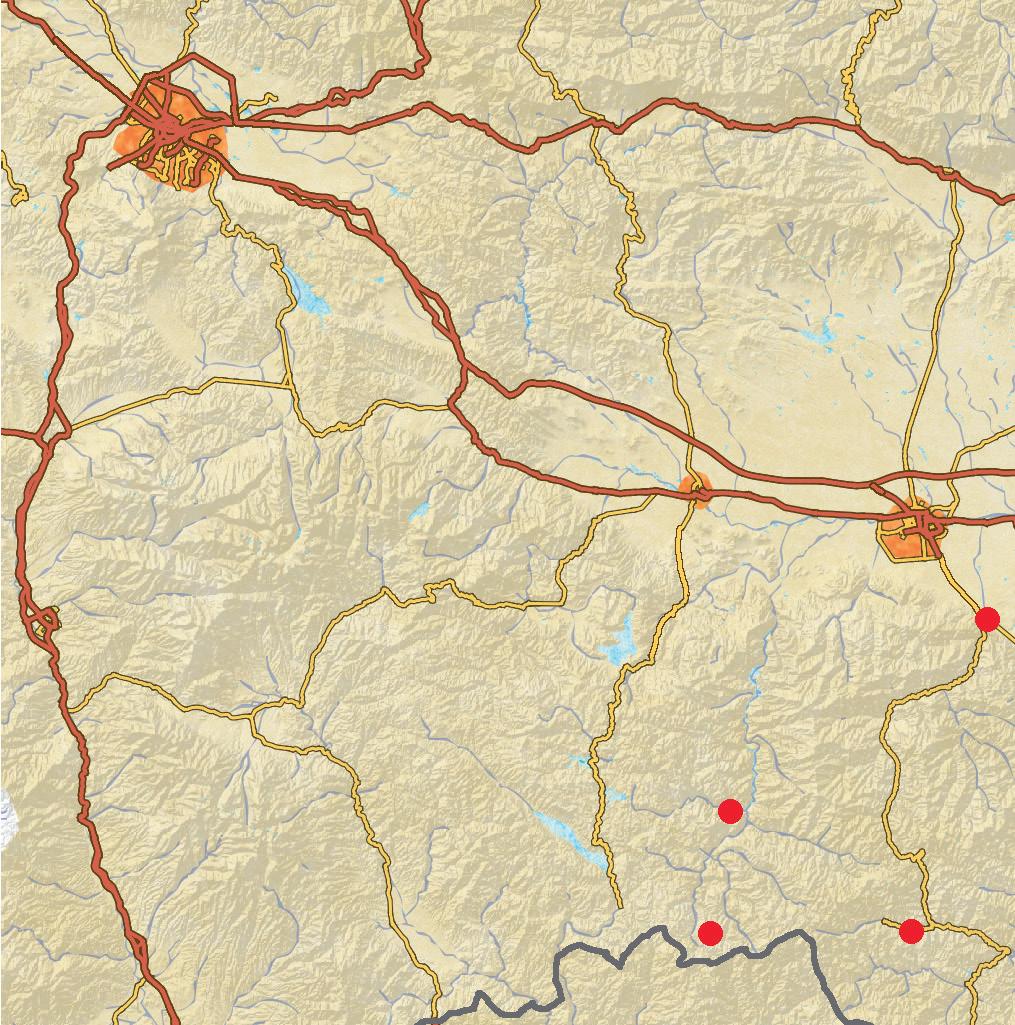
There are some odd geological features in the Rhodopes, such as these odd rock shapes, known as hoodoos or stone mushrooms (site B on page 184). They form where harder volcanic rock overlies and shields softer material of compressed volcanic ash.
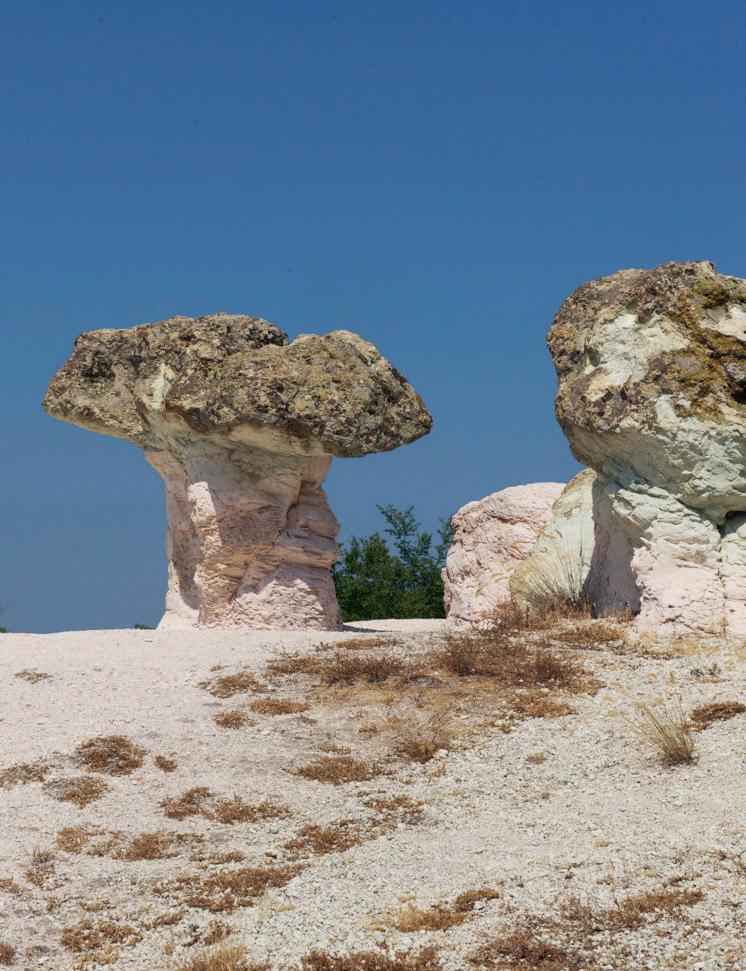
In geological terms, the Rhodopes are part of the Rilo-Rhodopes massif: a kidney-shaped range that lies for the larger part in Bulgaria with important branches in North Macedonia and northern Greece. This is one of Europe’s geologically more complex ranges as they are the result of confusing and still not entirely understood tectonics.
The tectonic plate theory famously describes the formation of mountains through the collision of large sections of the earth crust. The Alps for example, formed through the crash of the African and the Eurasian plates. Less well known is that on the edges of these large plates, there are smaller segments, known as micro-plates or terranes. They move somewhat differently and form distinct mountains in the pressure zones. It is in the light of these micro-plate tectonics that the formation of the Rhodopes should be understood.
The collision of plates and terranes pushed up sedimentary rocks, but also led to volcanic eruptions that resulted in a hodgepodge of different rock types. In the Rhodopes, igneous rocks (which derive from volcanic eruptions) are found side by side with sandstones and limestones that were deposited when the region was covered by the sea. There are also large areas with metamorphic rocks, which derive from other rock types that chemically and physically transformed under the extreme pressures and elevated temperatures created by the tectonic movements. And finally, of course, there are the young sediments, deposited by the rivers and seas in recent times. This variety of bedrocks mirrors, at least to an extent, the soils and the flora and fauna you can find in the various parts of the mountains. Some of the rock formations themselves are quite spectacular and have become attractions in their own right.
A brief geological history
Research has shown that the rocks that surface in the Rhodopes vary greatly in age. Young rocks date ‘only’ back to the Oligocene (25 million
years ago), but the oldest are a tenfold that age, stemming from the Paleozoic era (250 million years and older!). The latter are known as Variscan Massifs. They include not only part of the Rhodopes, but a wide variety of mountain chains all over Europe: the south German mountain ranges, the French Massif Central, Wales in the UK, central Iberia and several more. These Variscan mountains (also called Hercynian mountains) formed when two ancient continental plates (Laurussia or Euramerica on the one hand and Gondwana on the other) collided to form the super continent of Pangea, around 380-280 million years ago. Most of this ancient bedrock lies deep underneath the current mountains, which were formed at later stages.
Between 230 and 55 million years ago, Pangea broke up into the forerunners of our current continents. Present-day Africa was on one continental plate. At first it was merged with the American and Eurasian plates but as it broke loose, it tilted and closed the wedge-shaped ocean known as the Tethys, that separated the African and European plates.
The formation of the Rhodopes
A: the African Plate (AP) and Eurasian Plate (EP) move towards each other, closing the Tethys ocean.
B: The AP moves underneath the EP.
C: the immense pressure of this subduction changes the bedrock. This metamorphosed rock is pushed up. Locally, the old, marine limestones are lifted up as well. In the meantime, the same forces stretch the Eurasian plate, which becomes thinner and lower.
D: Part of the subducted plate starts to melt deep in the earth’s crust and is pushed up as magma, creating volcanic domes between the metamorphic bedrock and limestone pockets. The extended Thracian Plain is washed over by the sea, leaving the young marine sediments we see here today.

The Rhodopes form one of these wonderful areas in which you can spend the morning in cool mountains and the afternoon on warm plains; where you can enjoy the wildlife of dry, rocky slopes at the one moment and watch the herons and pelicans on a lakeshore the next. In short, there is a great range of habitats.
Extensive forests dominate the scene in the Western Rhodopes – they come roughly in three belts – coniferous at higher elevations, a belt of Beech lower down (especially on a north face) and a mixed oak wood in the warmer foothills and valleys. In many places, there are meadows in between, and more locally, karst grasslands – very rocky, creviced limestone pavement with a thin scatter of shrubs and many wildflowers. In these limestone environments, steep valleys and cliffs drop down to thunderous rivers.

Further east in the Eastern Rhodopes, the mountains are lower, warmer and drier. This mosaic landscape is typical of the Eastern Rhodopes –stands of oak mix with open scrublands and areas of pastures and rock slopes to form a hybrid landscape (see for example, the photo on page 8). In places, woodlands dominate (particularly on north slopes), while grasslands are found mostly on the level areas and reflect both historic and current grazing pressure of cattle and wild animals. The hottest and rockiest parts are reserved for a scrubland with a high variety of species, amongst which Christ’s-thorn, Wild Jasmin and Wild Lilac are the most eye-catching species.
The rivers in the Eastern Rhodopes are beautiful with pebble banks and islands, flanked by patches of woodland and set in wide valleys. They form a habitat of their own.
North of the Rhodopes (both east and west) are several dry, hilly areas. They are nearly treeless and steppe-like (the correct name for this grassland habitat is discussed on page 36) and boast a superb wildlife – one that is perhaps richest on the slopes of Sakar, east of the Maritsa River.
The Maritsa River valley with its fertile land and associated wetlands form the final habitat of the Rhodopes. These wetlands and riparian forests are rich in birds, but also butterflies, reptiles and amphibians.

The oak forests contain a large variety of different trees, besides various species of oak. These are century old Hornbeams.
beech, pine and oak woods of the western rhodopes grazing animals. Chamois, love these forests at this time of the year. Also Capercaillie seem to have a preference for the pine forests.
Roughly between 250 to 600 metres in altitude (sometimes higher), light oak woodlands cover the slopes of the Western Rhodopes. Sessile Oaks (plus the closely related Quercus dalechampii and Q. polycarpa) dominate the higher parts within this zone with Turkish (Quercus cerris) and Hungarian Oaks (Quercus frainetto) joining the mix lower down. The first has rather small leaves with pointy lobes, while the second has large and deeply lobes leaves. They grow together with a large number of other trees – Manna Ash, various maples, Hornbeam, Oriental Hornbeam and more. One frequently encountered tree is the Silver Linden, a south-east European species that has a curious adaptation to drought – it turns its leaves by a 180 degrees to point the downy-white underside towards the sun so they act as a reflector. The silver-grey canopies are easily spotted on the hillsides.
Despite the large variety of Balkan trees, the oak forests in the Western Rhodopes look rather like the oak forests further north – fairly tall trees with full canopies. This appearance changes rather drastically when you travel to the Eastern Rhodopes.

Routes 1-11 and routes 23 and 24 all lead through extensive areas with a mosaic habitat of forest scrub and pasture. The best routes to experience this unique landscape are routes 3, 4, 9, 10 and 11, plus site A on page 183. The limestone version of this habitat, including its special flora, is the prime attraction of sites B and C on page 193-194, plus some locations on routes 23 and 24.
This smorgasbord of interlinked habitats covers large parts of the Eastern Rhodopes and more locally Sakar. Here the oak woods rarely form large, unbroken tracts. Instead, they grow within a mosaic of dry grasslands and pastures, scrub, solitary trees, rocky slopes and small arable plots. All these different components merge fluently into one another, creating a sort of ‘meta-habitat’ that is spectacular in its diversity and beauty.

It is also very typical of a region in which the temperate biome of central Europe (where forests dominate) meets the Mediterranean (where scrubland is a key component) and the Eastern regions (where grasslands form the landscape). In the Eastern Rhodopes and Sakar, the landscape reflects this meeting point of biological realms (see also page 65). However, it would be misleading to say that the current landscape is entirely natural. In reality, grazing animals are the key to the formation and maintenance of this mosaic landscape. The Rhodopean Short-horn cattle, sheep and wild ungulates keep the landscape in this half-open state.
Large parts of the Eastern Rhodopes are covered with a mix of grasslands, rock, scrubland and woodland, which supports a very high biodiversity.
Various oaks dominate the woodlands, but they are seldom alone. Stands of Oriental Hornbeam, Manna Ash and Montpellier Maple are common, sometimes even outnumbering the oaks. In fact, these ‘oak’ forests in the Balkans have the greatest diversity of trees of any European forest type, with the oaks themselves forming a confusing bunch that have been the source of dispute amongst taxonomists and ecologists.
On the cooler, north-facing slopes, you’ll find the pretty Quercus frainetto, generally called Hungarian Oak (since these vernacular names are not used consistently in other texts, we provide the scientific names as well).
The Hungarian Oak is a beautiful tree with distinctive, large and deeply lobed leaves. It is about the only oak that is not difficult to recognise.

The Hungarian Oak shares its territory with the more widespread Turkey Oak (Quercus cerris) and Quercus dalechampii, the latter is sometimes considered a hybrid between Sessile (Q. petraea) and Downy Oak (Q. pubescens) and has intermediate characteristics.
On the warm slopes, there are ‘pure’ Downy Oaks, which are distinguished by the leathery leaves with pale, downy undersides. Downy Oak grow together with the aforementioned Turkey Oak and the Italian Oak (Q. vergiliana). The latter is a taller version of the Downy Oak, from which it is so hard to distinguish that botanists often consider them to be the same
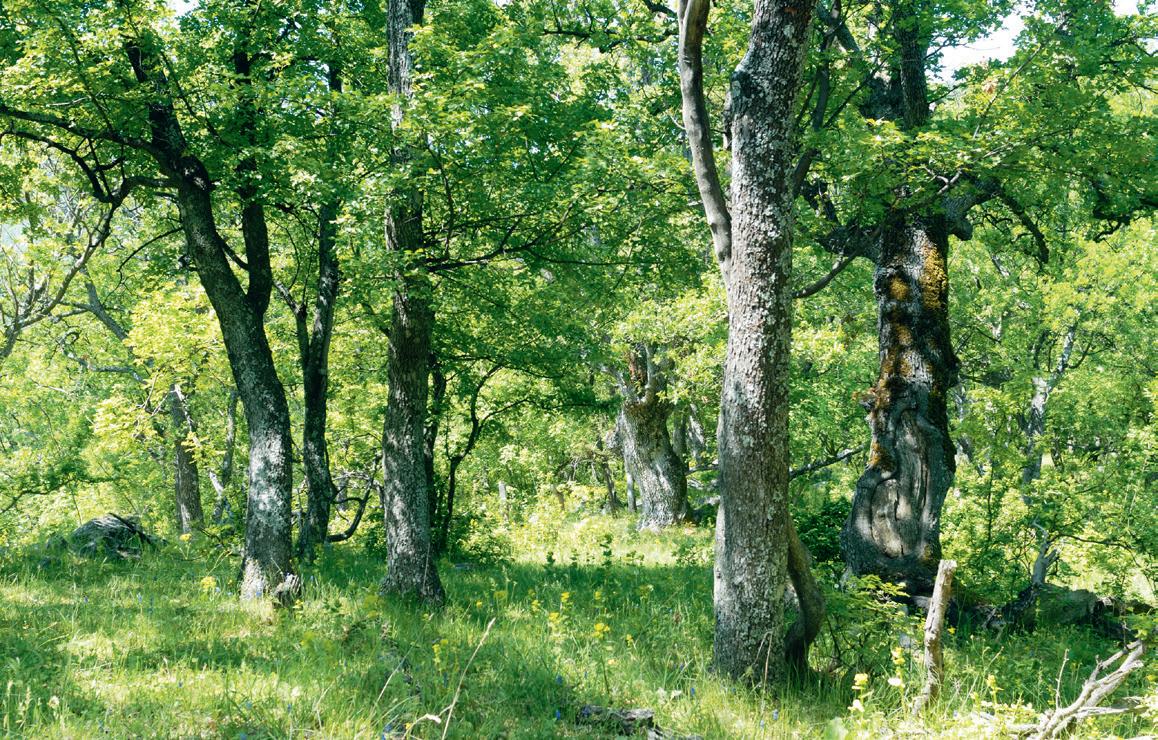
species. A large number of other oaks are listed for the region, but many of them seem to be hybrids or are simply synonyms for the aforementioned oaks. There is even one species, the Thracian Oak Quercus thracica, that is known from only a single specimen in the Eastern Rhodopes, near the village of Sarnak. It died in 2009 and the species is now considered extinct. In several places in the Eastern Rhodopes, you’ll encounter pinewoods, mostly of Austrian Pine. None of these are native but were planted for the timber production. You don’t need an expert eye to recognise that this project failed. The pines are all dead or dying, as this range is too hot and dry for the pines to thrive. Interestingly, the native range of the Turkish Pine lies just outside this region. The northernmost native stands of this east-Mediterranean tree are in Dadia Forest in Greece, barely 20 kms from the Bulgarian border. The sub-Mediterranean oak forests form a splendid backdrop for long walks in spring and autumn (in summer it is too hot). Through the open canopy, the sun creates a shifting mosaic of light and shadow on the grassy undergrowth. Every now and then, little streams find their way through the woods, supporting the aquatic Grass and Dice Snakes, often to be found sunbathing in open patches. In many places, drifts of Peacock Anemones, Stars-of-Bethlehem and thousands and thousands of pretty little Grapehyacinths colour the forest floor. This is also the place to look for orchids like Roman, Lady and Monkey Orchids, and for Pontic Fritillary. This type of forest is excellent for reptiles. It is warm and sunny, and because of the mosaic structure of the forest, more open habitat is usually not far away. There is also sufficient shelter and shade to retreat into. Hence, most reptile species can be found in good numbers in the open oak woodlands. Three-lined and Green Lizards will frequently cross your path, while the delightful tortoises (both Hermann’s and Spurthighed) simply just sit there in the middle of the trail, mimicking a rock.
In the drier or rockier parts, small trees and bushes replace the oaks –Wild Service Tree, Bladder Senna, Wild Lilac, Wild Jasmin, Cretan Cistus, Smoketree, Judas Tree, Wild Pistacio
The forest-scrubpasture mosaic has one of the highest concentrations and diversity of reptiles in Europe. Both Spur-thighed and Hermann’s Tortoises are common.

Grazing keeps the grasslands open. You can recognise the areas with a high grazing pressure by the bitten-down bushes with small leaves.

Tree and many more. Several of these are species proper to the Mediterranean, such as Cretan Cistus and Wild Pistachio tree. They become more numerous as you get closer to the eastern edge of the mountain range where the climate is warmest. Perhaps the most eye-catching of these shrubs is the Wild Lilac, which grows in profusion on the rocky slopes. This is the ancestral species of the familiar Garden Lilac and is native to a small region in eastern Bulgaria and Turkey, and again in eastern Asia. This peculiar distribution range is the result of the ice ages that led to the extinction of the Wild Lilac in the centre of its once extensive range.
Traditionally, scrubland is considered to be a transitional stage. When an abandoned grassland gradually turns to woodland, it passes through the stage of scrubland. However, in the (sub)-Mediterranean regions, scrublands can persist over a long time in places where drought, poor or shallow soil are unfavourable for a further succession to forest. These natural scrublands are found in the hottest and driest places of the Eastern Rhodopes and in Sakar, usually on south-facing slopes or on thin, rocky soil. The majority of scrubland areas, however, owe their existence to either the degradation of sub-Mediterranean oak forest or the abandonment of grazing. In the first case, development to forest is disrupted by cutting, grazing and the occasional fire. In the Rhodopes, many abandoned grasslands pass through a scrubland phase before reverting to young oak woodlands. However, since the climate is already tough on trees it takes a long time before trees replace the bushes, particularly on shallow ground. Throw in the natural grazing and an occasional bushfire and it is easy to understand that the scrubland is not just a phase but a permanent natural habitat in the lowland parts of the region.
The scrublands of the Eastern Rhodopes and Sakar are not to be confused with the evergreen macchia (maquis) of the Mediterranean region. In our region, it is the deciduous Christ’s-thorn shrub that plays a key role. This bush is easily recognized by its combination of parallel leaves, thorns and fruits that look like flying saucers. It is reputed to have been used as the thorny crown Christ had to wear on his way to the cross (hence its name Paliurus spini-christi ). Christ’s-thorn grows on the poorest and hottest soils, frequently together with Wild Jasmin. In places with a little more nutrients, Hawthorn and various fruit trees like Wild Pear may grow. Another big difference with the Mediterranean scrublands is the patchy character of the Rhodopean scrublands. In most places, the bushes are scattered over dry grasslands. The ecology, flora and fauna of these scrublands is therefore very much connected to the open spaces in between. The bushy grasslands (or are they grassy bushlands?) are one of the focal habitats for birdwatchers, as it is here that a large number of south-east European bird species are found – e.g. Black-headed Bunting, Barred, Eastern Subalpine and Eastern Orphean Warblers and a variety of shrikes. Most strongly linked to the Christ’s-thorn scrub is the (therefore ill-named) Olivetree Warbler. Additionally, one of the more attractive butterflies of the area, the boldly pattern Little Tiger Blue, is exclusively found around these shrubs.

In the Eastern Rhodopes, the larger areas with dry grasslands are found on the gentle slopes and level land on the ridges. This pattern – woodland on the slopes and grassland on the ridges, is again the result of grazing –the level parts are more accessible for both sheep and people – the first to graze and the second to collect wood. The dry pastures have a steppe-like appearance, especially towards the summer when the spring flowers have disappeared and the once green grass has turned to golden straw. The dry pastures of the Eastern Rhodopes are somewhat reminiscent of the karstic plateaux of the Western
The Christ’s-thorn bushes with their typical appearance cover large parts of the driest and hottest slopes (top). This habitat has a rich birdlife. The Woodchat Shrike is one of the more conspicuous birds (bottom).
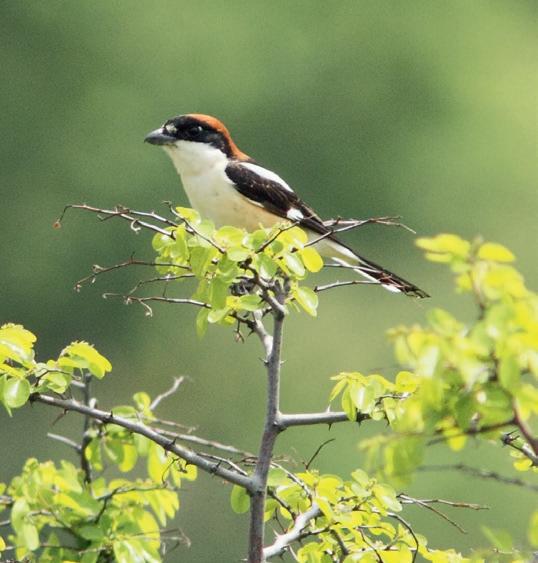
One of the problems (from an ecological point of view) is the ploughing of the grazing ground, made possible as more and more land change from communal to private ownership. The sheep and the susliks both need this communal grazing ground, and with them comes an entire ecosystem from wildflowers to birds of prey.
Sadly, the EU subsidies play a dubious role. On the one hand, Europe provides money for nature conservation, but on the other hand it also finances (with a much bigger purse) the ploughing of grazing land and (in the Rhodopes) the mass clearing of scrub. Much of the conservation money is spent minimise the problems caused by other EU funds!
In the mountains, grazing is an issue too, but here, fortunately, most of the land has not been privatised. One of the great perks of the Rhodopes, in fact of pretty much all mountains in Eastern Europe, is the near absence of fences. With the exception of some sensitive ecological sites, you are free to go as you like in the countryside. Just park besides the road where it looks good and stroll into the pastures or the woodlands. In that sense, this really is the land of the free – who would have guessed that as a heritage of the communist era!
The Eastern Rhodopes is one of those European regions where the rich landscape of traditional grazing and wood cutting – activities that have over centuries greatly enhanced biodiversity – has been well preserved. But this is not to say that the big changes in the 20th century have left the region unaffected. The creation of reservoirs has destroyed part of the Arda river and surrounding lands. The planting of pine woods, instead of native woodlands, takes yet another bite out of the pristine fabric of the Eastern Rhodopes. Fortunately, there are no plans for new plantations. However, there are plans for big wind turbine parks on the mountain peaks on both sides of the border. These parks present a particularly tricky problem for conservationists, on the one hand, the increasing use of renewable energy sources is to be applauded, but, on the other hand, the chosen locations have a very negative effect on birds of prey, migratory birds and bats. They are also such a blemish on the natural landscape, that they provide a key focal point for Bulgarian conservationists. Power lines are another major threat to birds in general and raptors in particular. An investigation carried out by the Bulgarian Society for the Protection of Birds (BSPB) found that whilst White Storks and Common
Buzzards were the main victims, globally threatened species such as Egyptian Vulture and Imperial Eagle were also electrocuted. Finally, hunting and poaching continues to be a big problem. Poisoning also happens although it is not as big a problem as across the border in Greece where in 2010 the entire Griffon Vulture and Golden Eagle populations in the Nestos gorge were wiped out by illegal poisoned bait. This was shocking news, but the explanation behind this act made it even worse: it wasn’t even meant to kill the birds, but wolves. Indeed, herdsmen on both sides of the border see Wolves as important enemies of livestock, and poisoned bait is regarded as a good way to get rid of them. Eagles and vultures are collateral damage. There are already compensation schemes for damage to livestock in place, but they are either not sufficient, not adequate or not well enough known. Despite damage being hardly reported, poisoning is still taking place.
In Bulgaria almost 34 percent of the land is currently protected in the Natura 2000 network of protected areas. After Slovenia and Croatia, this is the highest amount in the European Union!
As far as the Eastern Rhodopes are concerned, many parts of the region are also under official Natura 2000 protection. Great stretches of the Arda river system and that of the Byala Reka are covered by Natura 2000 and are nationally protected areas as well. Various national and foreign nature organisations are active in the
Traditional grazing with sheep has diminished enormously and with it, wildlife is disappearing too. In particular the species of steppe-like landscapes, such as Susliks and birds of prey are under pressure.

62
region, including WWF, Green Balkans, BSPB and Rewilding Rhodopes. We teamed up with the latter to write this guidebook. The BSPB/BirdLife is fighting for a more sensible deployment of wind energy and opposes the building of wind turbines in the areas key for birds. The organisation was very successful in their efforts to recover the vulture population in the Rhodopes. The population of Griffon Vultures increased from about 15 pairs to more than 110 pairs and the Egyptian Vulture population stabilised. Black vultures are being reintroduced in 2022-23 by Rewilding Rhodopes (see text box).
In order to retain the traditionally grazed landscape, Rewilding Rhodopes has brought back different species of grazing animals. The impressive European Bison roams the Eastern Rhodopes again since 2013 and can, with a little luck, be seen in the mountains near Potochnitsa (route 9).

In collaboration with the power grid operator EVN and with support from the EU LIFE program, BSPB/Birdlife insulated thousands of dangerous electricity poles in Eastern Rhodopes and Sakar thus contributing to the recovery of the national Imperial Eagle population from about 15 to 41 pairs.
In 2022, BSPB/BirdLife started a large forest and grassland restoration project along the Green belt from Eastern Rhodopes to the Black Sea supported by the Cambridge based Endangered Landscape Program. In Sakar, the Green Balkans works together with the German-European NGO EuroNatur in a project to reintroduce and secure the population of Lesser Kestrels.
Rewilding Rhodopes works in the Eastern Rhodopes where it develops sustainable initiatives that promote and combine nature conservation, green business and education. This is an encompassing approach, typical of rewilding projects in general: the notion that a robust and healthy ecosystem (‘wild nature’ in terms of Rewilding Rhodopes) should be the basis of a sustainable society and actually supports the economy, culture and general well-being of the people that live in and visit the area. Supported by Rewilding Europe, the Rewilding Rhodopes does all of its work with local stakeholders, be they hunters, farmers, the tourism business,
officials or a combination of them. One focus is on restoring the grazing regime that once sustained the patchwork landscape of the Rhodopes. With the (gradual) disappearance of the herds of sheep and – to lesser extent – cattle, Rewilding Rhodopes turns to wild grazers to supplement the domesticated grazers. Red Deer, Konik Horses and European Bison have been introduced, which, combined, will maintain the semiopen landscape and in the meantime provide an income in the form of hunting and ecotourism. The grazers also create a niche for predators and scavengers like vultures and eagles which, in turn, also improves the region’s attraction as a tourism destination. It is this kind of interplay between people and their surroundings that create a mutual benefit that enables both people and wildlife to thrive.
Ecotourism – that means you – is thus one of the trump cards of nature conservation in the region. It gives value to nature, economically by generating income for the local communities and ethically and culturally by showing that nature has an intrinsic value – a value that is great enough to draw visitors from all over Europe to the region. On page 258 you can see what you can do to support conservation of the area.
The non-profit organization Rewilding Rhodopes strives to support and strengthen the region’s biodiversity. One of the threats that face the Eastern Rhodopes is the gradual encroachment of shrubs and forests due to the decrease of livestock. Therefore, Rewilding Rhodopes is introducing various species of native grazing animals which together should maintain a half-open landscape.
The Rewilding Rhodopes’ team has reintroduced over 50 Red Deer and 600 Fallow Deer. In 2011, the first twelve Konik Horses were set free in the mountains. Currently over 100 Wild Horses roam the slopes (of both the Konik and Karakachan race). Similarly in 2013, a small herd of five European Bison was brought to the area of Studen Kladenets. Ten years later their population has grown to 16. Currently, the team is analysing grazing practices in the Eastern Rhodopes and preparing recommendations for more sustainable grazing systems.
Between 2016 and 2021, as part of a LIFE project, Rewilding Rhodopes together with Bulgarian and Greek partners worked on stabilizing and growing the Griffon Vulture population in the Rhodope Mountains. Building upon that experience in 2022 the organization released 14 Black Vultures, as part of a new long-term reintroduction programme that aims to establish a second colony of Black Vultures on the Balkans, besides the one that is present in the Greek Dadia forest.

The flora and fauna of the Eastern Rhodopes, Sakar and the Thracian Plain form one big, fascinating cabinet of natural curiosities, comprising many species unfamiliar to most Europeans. There are, of course, the raptors and vultures for which the area is famous, but you can also come across subterranean worm-like lizards, curiously shaped orchids, hill-roaming jackals, dwarf irises, paradisiac lilies, gigantic predatory bush crickets and a myriad of other strange insects. If the oddities of this part of the world were presented in a single catalogue, you’d be amazed by such diversity of life in such a small area. There is no single reason explaining this abundance, but the varied topography certainly is one positive contributor. On the one hand, there are rugged hills and mountains with large forests and cliffs of an overall impenetrable and wild character and on the other, there are open plains. These consist of fertile soils that support numerous different species providing prey for the many raptors. The wide range of habitats, from wetlands to scrubland, various types of forest, karstic plains and agricultural land, offer a home to a wide variety of species. One major factor that positively influences the natural diversity of the region is its position in the contact zone of several of the main biological regions. The Rhodope Mountains support plants and animals that are well-known throughout central Europe (like Beech trees and Fire Salamanders for example). Higher up in these mountains, you encounter sub-alpine boreal species; those that are typical of the coniferous forest zone of the central European mountains and northern Europe. Examples are Capercaillie, Ghost Orchid and the Apollo Butterfly). If you look carefully, you’ll find many other species in these realms that are unique to the Balkan countries. Particularly among the flora and insect fauna, there are many uniquely Balkan species, such as and the Balkan Fir* (Abies borisii-regis) and the Rhodope Avens* (Geum rhodopeum). A few of them are even restricted to the Rhodopes themselves, such as the Bulgarian Emerald (a dragonfly) and the Rhodope Lily.
Species of open woodlands and small-scale agricultural land, such as this Hoopoe, do well in the Rhodopes.
In the Rhodope Mountains, various biogeographical regions meet. It is here that you can find together the Red-back Shrike of central Europe (top), the Lesser Grey Shrike of eastern Europe (second), the Woodchat Shrike of southern Europe (third) and the Masked Shrike of southeastern Europe.

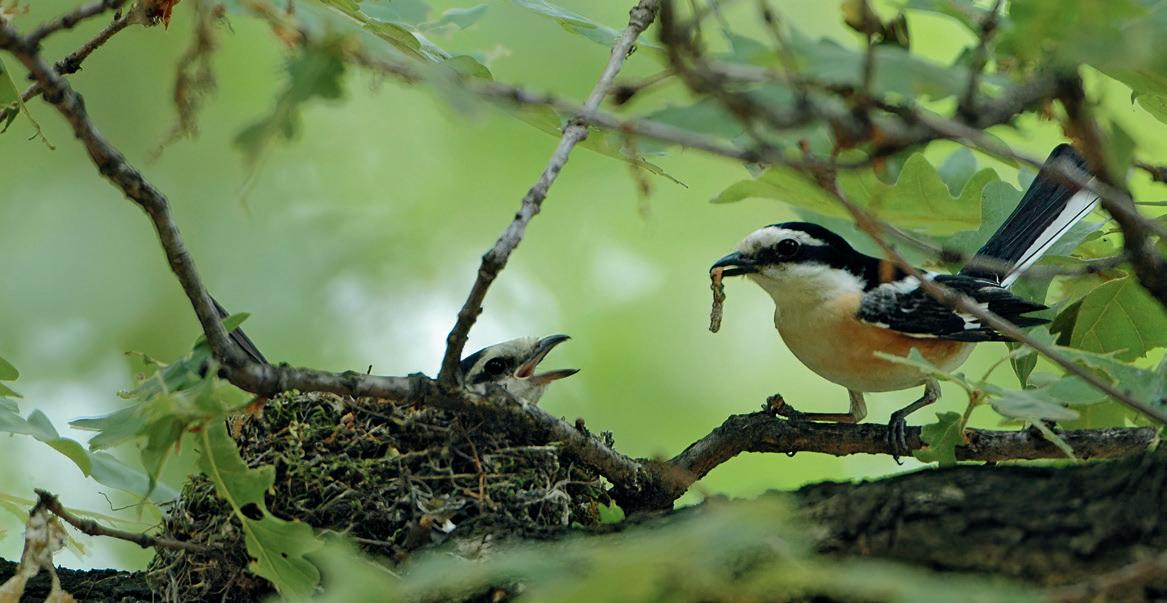
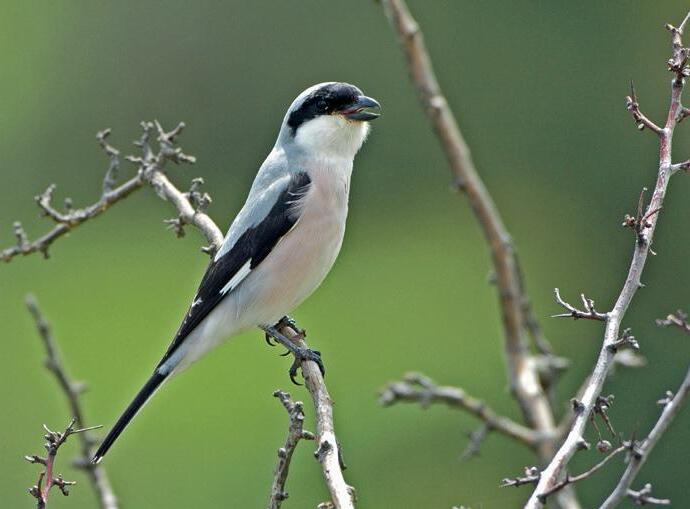

The lower Arda and Thundzha rivers and the Ivaylovgrad region, in contrast, is dominated by Mediterranean plants and animals, such as Cretan Cistus and Kotschy’s Gecko. Many of them reach further up into the Rhodopes and Sakar as well (e.g. Pink Butterfly Orchid, Eastern Festoon (a butterfly), Masked Shrike and Eastern Olivaceous Warbler, to name but a few). Among these Mediterranean species are several distinctly eastern ones, which just reach this region. Examples are highlights like Bronze Bush-cricket, Sand Boa and Spurred Helleborine (an orchid).
And then there is the Pontic element – species proper to the steppes and steppe woodlands of the Black Sea region and further east. The ‘Pontics’ are the cherry on an already pretty well decorated cake, and include the likes of Suslik, Isabelline Wheatear and both pelicans. Time to dig in!
Temperate European

Yellow-bellied Toad

Bombina variegata
Brooks, pools
Pontic
Suslik
Spermophilus citellus

Deep-soil Steppes
Temperate European region
Pontic region
Rhodopes
Mediterranean region
Alpine
Apollo
Parnassius apollo
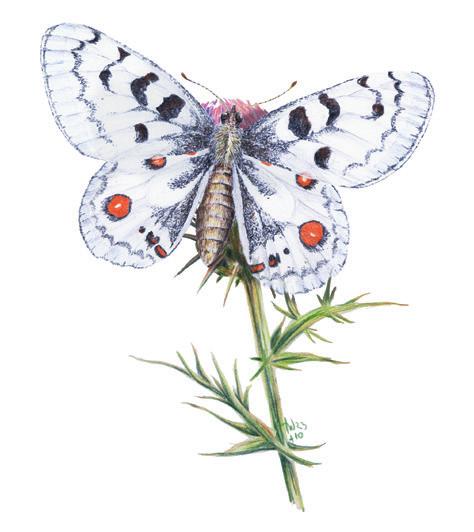
Karst plateaux
East Mediterranean region
East Mediterranean
Olive-tree Warbler

Hippolais olivetorum
Christ-thorn scrub
Rhodopes Endemic
Rhodope Lily
Lilium rhodopaeum
Subalpine meadows

been joined by European Bison which roam the Eastern Rhodopes, again in the general vicinity of the hunting reserve.
The grazing fauna of the Western Rhodopes is less diverse. Besides Wild Boar, Roe Deer and Red Deer, there is one other ungulate in this region: the Balkan Chamois. This animal is closely related to and virtually indistinguishable from the Alpine Chamois, and roams the mountain forest glades, roughly above 1,000 metres.
Mammalian life in the steppes is quite different from that of wooded parts of the country. Although ‘true steppes’ are rare in the region (see page 35) but the open grasslands and fields with sufficient soil to make burrows form a good substitute. Because this is open country with great all-round visibility, the ability to hide underground is vital. The Suslik (or European Ground Squirrel) does precisely that – creating elaborate burrows in steppes and other terrain where they are found. They reproduce quickly and can, in suitable habitat, be very numerous. Susliks feed on seeds and herbs and always remain close to the burrows, because there are plenty of predators around that have Suslik on the menu – Saker Falcons, Long-legged Buzzard, Montagu’s Harrier, Imperial and Lesser Spotted Eagles – they all love to eat Susliks. And so does the Marbled Polecat. This panther-patterned version of the Polecat shares the Suslik’s habitat but unlike the birds of prey, they can enter the suslik burrows to hunt these rodents down.
In a healthy steppe ecosystem, Susliks form an important food source for these predators. Sadly, the numbers of Suslik have dropped hugely over the last few decades. Without doubt, the intensification of agriculture and the transformation of grazed steppes to ploughed fields are major reasons for the Suslik’s decline in the Thracian Plain. However, it is likely that there are other, yet unknown, causes for the low numbers, especially in the Rhodopes. Here, many apparently good Suslik territories are not inhabited and there seems to be a

mammals
link between the decline in sheep grazing and the disappearance of the Suslik. Additionally, the isolation of the deep-soiled areas in the otherwise rocky terrain prevents recolonisation of former breeding sites. Most sites inhabited sites in the Rhodopes are in or close to the Arda and Amira River valleys. In the Thracian Plain and especially around Sakar, there are much larger populations.
Susliks and Marbled Polecats are by no means the only steppe mammals. Hares and Hedgehogs are common and close to river valleys, there are plenty of Golden Jackals.
The list of rodents and small insectivorous animals is too long to describe fully, but there are two odd ones we wish to highlight here. The first is Roach’s Mouse-tailed Dormouse, a mouthful of a name for a small and inconspicuous species. The story behind this small rodent is fascinating. It is one of those animals with an extremely secretive lifestyle and very specific habitat requirements. It lives only in European Turkey, a few isolated places in the very western edge of Anatolia and south-east Bulgaria. This animal is so rare that it has been considered extinct in Bulgaria. The last sighting was in 1978, but in 2017, it was suddenly rediscovered. Or more precisely, its remains were discovered in owl pallets, after which a more thorough search found populations in Sakar, locally in the Eastern Rhodopes and in Strandzja. Like all (European) dormice, the Mouse-tailed climbs in bushes and trees (where it needs holes to sleep and nest in), but in contrast, mostly feeds on the ground. The second is the Lesser Mole-rat, a very strange rodent that, like a mole, lives almost exclusively underground. Only after heavy rains it leaves its burrows and may suddenly be seen crossing the road (which happened near Madzharovo when we were exploring routes for this book in 2022).
It is these latter two animals (and the great diversity of mammals in general) that has generated a lot of interest recently among mammal researchers in the Rhodopes and Sakar.
Roach’s Mouse-tailed Dormouse is perhaps our continent’s least known mammal. It has a very small distribution range, but it may not be all that rare in the Eastern Rhodopes and Sakar.

The best birdwatching routes are 1, 5 (both cliff and wetland birds), 8, 9, 11 and site A on page 181 (river and scrubland birds, raptors), 17, 18, 19 and 20 (all for the birds of subalpine forest), site A on page 222 (for Wallcreeper primarily), 21, 23, 24 and site C on page 249 (for the birds of steppes and dry grasslands) and route 22 and sites A to E for wetland birds. For a species-specific account of where to watch birds, see the list on page 264.
The Rhodopes and adjacent plains rank among the top birding sites in Europe. This area matches the famous birdwatching destinations of Spain, Southern France and Eastern Poland. Within a 10 day to two week visit at the peak time (2nd half of May) it is possible to see such delightful species as Masked Shrike, Levant Sparrowhawk, Olive-tree Warbler, Eastern Imperial Eagle, Western Rock Nuthatch, Sombre Tit, Dalmatian Pelican, Wallcreeper, Pygmy Cormorant and Rose-coloured Starling – to name just a few of the highlights. Again, the fact that this region is the meeting point of temperate, Mediterranean, Pontic and Alpine species makes it also the meeting point for species from different regions. Classic Mediterranean species like Beeeater, Squacco Heron, Blue Rock Thrush and Roller are present here mixed in with eastern specialties, Isabelline Wheatear, Olive-tree Warbler and Eastern representatives of Subalpine, Olivaceous and Orphean Warblers. Some of them reach in the Eastern Rhodopes the western end of a range that stretches out over Turkey into the Middle East, like Western Rock
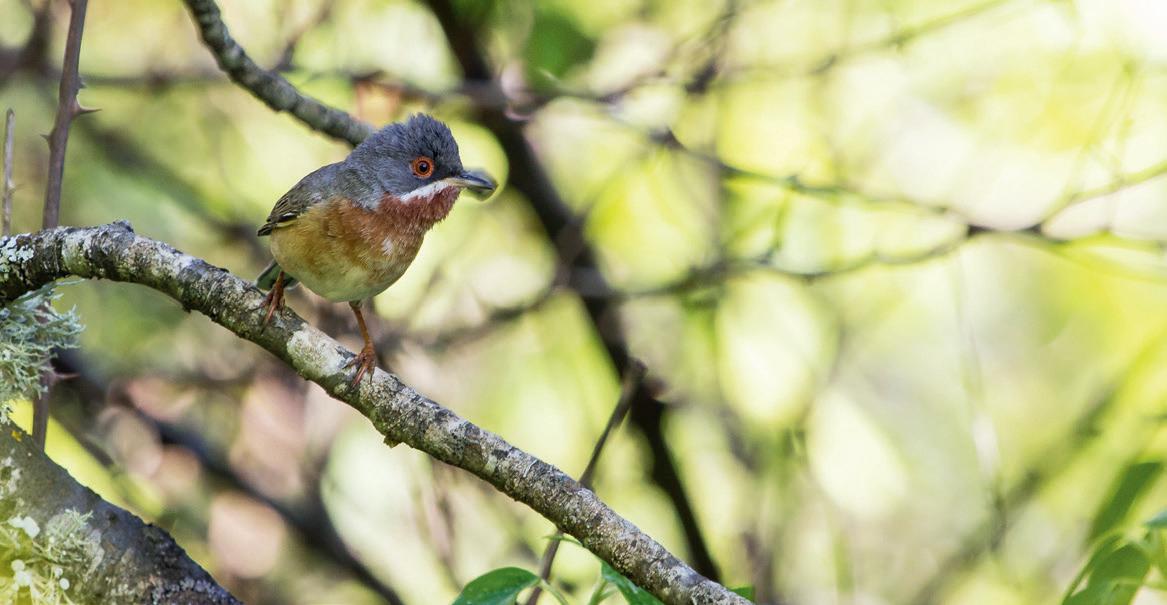
Nuthatch, Masked Shrike, Chukar and Levant Sparrowhawk. These are understandably among the most attractive species for birdwatchers from western Europe.
Due to the Rhodopes’ eastern position in Europe, the temperate birds have a distinctly eastern flavour. The mountain woodlands support Grey-headed and White-backed Woodpeckers (a misnomer here as the local race, lillfordi, has a barred back), while Syrian Woodpecker, Barred Warbler and Lesser Spotted Eagle breed in the lower areas. Even the passage migrants are often distinctly ‘eastern’, wintering in East Africa or the Middle East and having an east-European or Siberian breeding range. Examples are Marsh Sandpiper and White-winged Tern, which can be seen in the area on spring migration with relative ease.
The dry, steppic lowlands form another birding hotspot with PonticPannonian specialities such as Lesser Grey Shrike, Rose-coloured Starling (in some years), Eastern Imperial Eagle and Isabelline Wheatear. The cherry on this already well-decorated cake is found in the higher regions of the Western Rhodopes, where a number of northern and Alpine species are present, such as Capercaillie, Three-toed Woodpecker, Wallcreeper, Nutcracker, Tengmalm’s Owl and Pygmy Owl.
It is not just the mix of different biological regions though, that makes this region so rich in birds – it is also the large number of different bird habitats and the generally great condition they are in. Birds of small-scale agricultural land that are rapidly disappearing in Europe –shrikes, Little Owls, Ortolan Buntings and Turtle Doves are still doing relatively well here, although they are now declining in the intensified and subsidised large-scale farmland areas in the Thracian Plain.
The best bird habitats are the cliffs and rocky slopes in the Eastern Rhodopes, the shrubby pastures with their scattered oaks and woodlands, and the river floodplains in the mountains. This is where a large number of the highlights are found. Additionally, however, there are a number of generally small marshes and lakes, mostly in the Thracian Plain, which combined support almost all of the wetland species of south-eastern Europe – nearly all European herons, Glossy Ibis, Pygmy Cormorant, Great White and Dalmatian Pelican – even Collared Pratincole is present.
All this paints a picture of the Rhodopes as a birdwatcher’s nirvana, but this is not entirely true. Before going into detail about the different bird regions, it needs to be said that finding the full range of specialties is not an easy task. Some sought-after species occur in very specific places and for them, you need to know exactly where to go. With this guidebook, that should be easy. Many others are simply scattered thinly over suitable hab -
itat and an element of luck is involved in finding them. This goes for the raptors, but also for many of the passerines, which are by far easiest to find when they sing. Knowing their songs and being present in the season and at the hour they are most vocal are important means by which you can increase your chances of finding them. Hiring a local guide for a day or two is another excellent option for finding some of the more difficult local specialties (see page 263).
The region covered in this book lies close to but not on a major bird migration route. Migratory birds in spring overwhelmingly follow the Turkish coastline north and reach Europe in the Evros (Maritsa) delta that forms the border between Greece and Turkey. Some travel upriver from there and pass along the marshes of the Thracian Plain for a bit – waders, terns, swallows and passerines can be seen in large numbers in this period. However, the majority of the broad-winged migrants maintain a course along the coast, flying north along the great lagoons along Bulgaria’s Black Sea coast. Some of the species mentioned here as very scarce passage migrants (e.g. Spotted Eagle, Pallid Harrier) are in fact much more numerous on the coast, which is one of the reasons many birdwatchers combine a visit to the Rhodopes with birdwatching on the Black Sea coast.
Of all the bird groups of the region, the raptors are arguably the greatest attraction. The Arda River Valley in the Eastern Rhodopes, Sakar and the Thracian Plain, in particular, have a joint reputation of being amongst the most raptor-rich areas in Europe (together with the Dadia forest just across the border in Greece). In terms of species diversity, this is certainly the case. No less then 23 out of 38 raptors of the European mainland breed in the area, and a few more winter or pass through. The diversity of raptors is impressive, but the majority of them are not very common and some are downright rare. If you have been watching raptors in Spain, you should realise that even though the diversity of birds of prey in southern Bulgaria is higher, the numbers are lower. The vultures are, perhaps, the most striking and visible. Griffon and Egyptian Vultures occur in good numbers – For both of these cliff-breeding species, this region is the stronghold in eastern Europe. A census in 2022 on the Bulgarian side of the Rhodopes revealed 111 pairs of Griffon Vultures, with another 50 or so unpaired birds. Close to 20 pairs of Egyptian Vulture are known from the Bulgarian Eastern Rhodopes. These birds form a single, large Rhodopean population that stretches out across the Greek border where a smaller number of both these vultures breed. The situation
is reversed with the Black Vulture, which breeds on the Greek side (Dadia forest) and is regularly seen in the Bulgarian Eastern Rhodopes. However, in summer 2022, the Black Vulture was also reintroduced to the Bulgarian Eastern Rhodopes in the vicinity of Madzharovo, so by the time you are reading these lines, it is much more likely that you’ll be able to see these majestic birds on your trip (the Black Vulture is, with a wingspan of almost 3 metres, the world’s largest bird of prey after the condors). Eagles are the next big draw. Golden, Eastern Imperial, White-tailed, Lesser Spotted, Booted and Short-toed Eagles are all frequent. However, the numbers seen on a spring trip vary from year to year – in some years you’ll see plenty, while in others they are, for some reason, quite scarce. Sakar is the best location for eagle-watching. The key species is the Eastern Imperial Eagle, of which 30 pairs breed (out of a total Bulgarian population of about 40 pairs). Impressive numbers, especially when you consider that this doesn’t even make it the most common eagle (that would be the Lesser Spotted). The Imperial Eagle hunts for rodents in open flat or slightly hilly terrain. Classically, Hares and Susliks are its main prey; and the disappearance of the sheep herding and conversion to ploughed fields is a major threat to the Suslik and therefore to this superb raptor. Interestingly, in recent years, the Imperial Eagles of Sakar are focussing more and more on another prey: hedgehogs!
You will have little difficulty observing Griffon Vultures at the cliffs along the Arda or from one of the photography hides in the Eastern Rhodopes (see page 263).
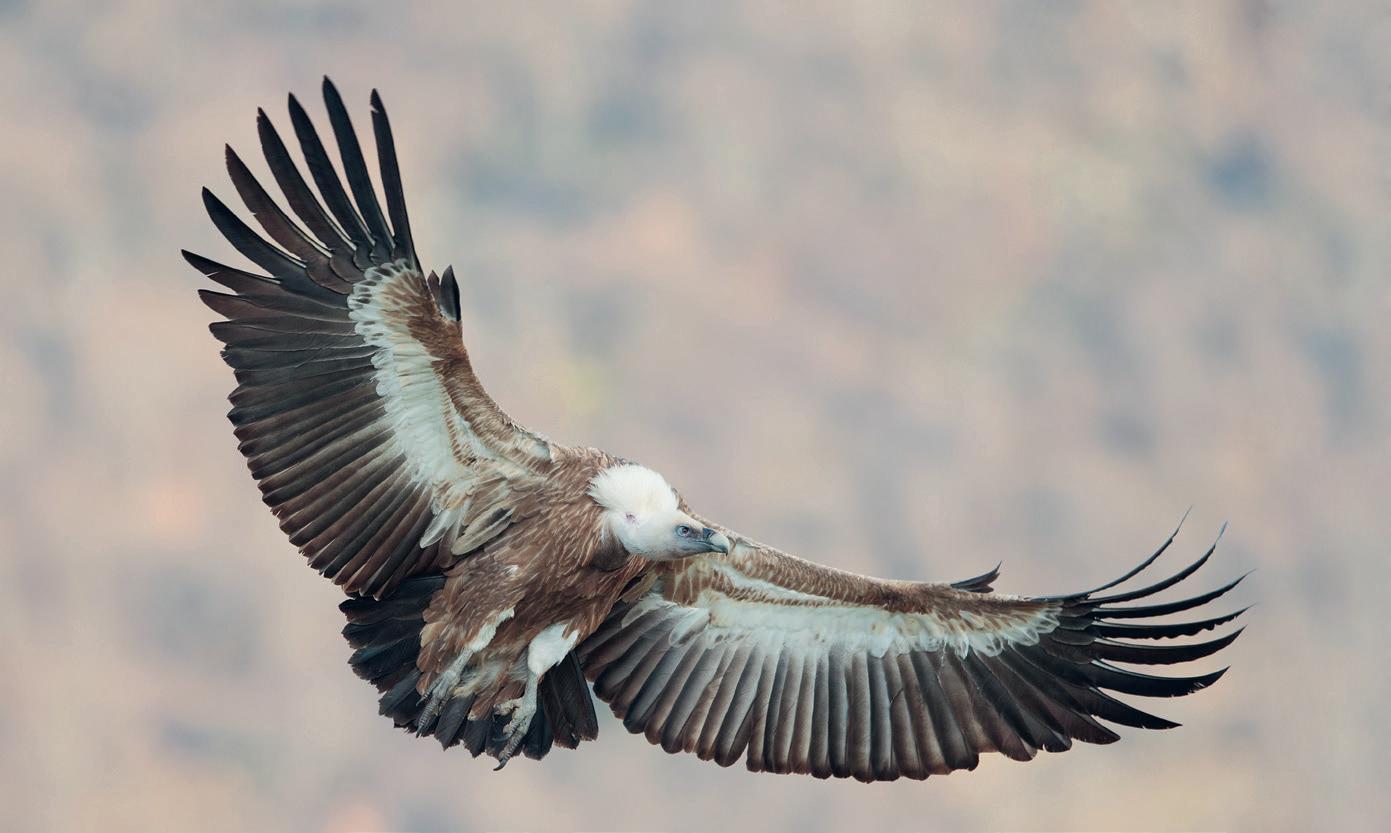

In this part of the guidebook we recommend routes that are particularly well suited for seeing the many specialities of the area. The routes are centered in five areas. The fi rst three – Madzharovo, Kardzhali-Momchilgrad and Ivaylovgrad – are situated in the Eastern Rhodopes. The fourth covers the Western Rhodopes and the fi fth the large region of the Thracian Plain and Sakar Mountains. For each of these regions we provide detailed descriptions of walks and car routes, plus a series of other sites of interest. These are not lesser sites. We have chosen to describe them more briefly because they are either smaller, more straight-forward to cover, or because they explore similar habitat, flora and fauna as the more extensively described routes. The map in the inner back cover shows the location of the various regions.

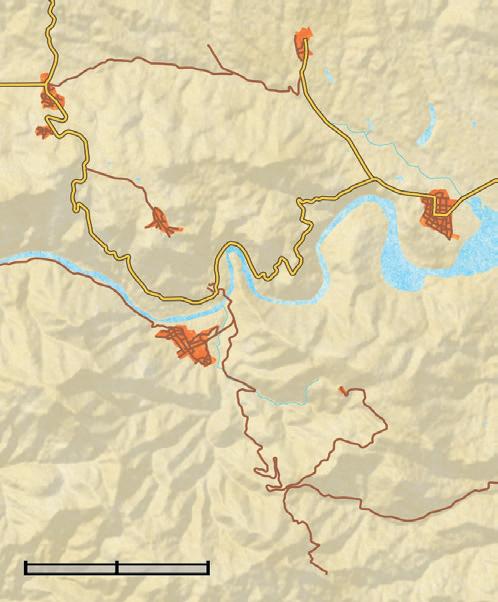
If there is one part of the Eastern Rhodopes that can be called the core area for naturalists, it is Madzharovo. Here all the key elements come together within a small area – the finest stretch of river, the main cliffs with raptors, some marshes, brooks and extensive woods and scrubland. There are some good opportunities to explore on foot, as well as some quiet backroads to drive. Because of this, there is concentration of rural B&Bs, a visitors’ centre and a restaurant that are used to cater to naturalists from abroad, plus there are various guides, a bicycle and canoe rental – in short, all you need as a visitng naturalist but all still very low key. The next four routes (1 short car route and 3 walks) are all in the vicinity of the former mining town of Madzharovo, which is worth visiting for its own right (see box on page 59).
The Arda River (route 1, 2) and the Kovan Kaya Cliffs (route 1) are definitely highlights of this area and should not be missed when visiting the region. Although the cliffs are part of the car route, you can easily visit them on foot; only 20 minutes from the visitors centre via the quiet road. You can also explore routes 8 and 9 from Madzharovo as these sites are only a 50 minute drive away.
The famous vulture cliffs of Madzharovo. Scenic route with a rich birdlife.


Habitats: river, scrubland, stony grasslands, cliffs, oak forest, fields, marshland Selected species: Pink Butterfly Orchid, Jackal, Otter, White-tailed Eagle, Black Stork, Griffon Vulture, Peregrine, Golden Eagle, Western Rock Nuthatch, Blue Rock Thrush, Rock Bunting, Sand Boa, Small Bath White, Russian Heath, Sandy Grizzled Skipper, Freyer’s Purple Emperor


The horseshoe river bend of the Arda river with the jagged cliffs of Kovan Kaya is easily the most iconic place of the Eastern Rhodopes. It is where the main vulture colony of the region is to be found and standing underneath the cliff and watching the vultures drift over your head on the one side and the Black Storks feeding in the wild Arda river on the other is a spine-tingling experience. This scenic route explores this area and then takes you beyond these places and into a broad valley with, for the region, atypical marshlands. Like many routes in the region, the birdlife is splendid, but there is much more. The Arda river functions as a corridor of Mediterranean species that have their Bulgarian stronghold in this valley and in just a few other southern rivers (see page 112).
This route is described as a car route with stops and short strolls. Alternatively, you can easily make the first half of it a walk. There is so much to see that you may want to simply walk up to point 4 along the road, which is usually quiet and has very little traffic.


Starting point Vulture centre, Madzharovo (GPS: 41.643198, 25.871804). The centre is situated next to the bridge over the Arda River.
1The ‘vulture centre’ is a nature information centre of the Bulgarian Society for the Protection of Birds (BSPB). It has a small but good restaurant, café and also functions as a small hotel. It is the main hub for nature tourism in the region. Situated on a steep north slope of the river, under the canopy of tall Hungarian Oaks with their large, deeply lobed
leaves, it is an idyllic spot, especially in hot weather. Local English-speaking ecologists provide up to date information on the area and its species. In the evening, the terrace lights in front of the centre attract many moth species like Cream-spot Tiger, Eyed and Small Elephant Hawk-moth and the impressive Giant Peacock Moth, which often rest on the vegetation near the lamps.
2From the vulture centre, walk to the bridge and enjoy the great views of the cliffs of Kovan Kaya and river with its pebble banks and patches of willow and aspen. Scan the shores for Black Storks which are often in the river and you should see the first vultures flying near the cliffs. Just before the bridge there’s an open space next to the road. At the western end of it, a trail leads down to the river. This is worth exploring, especially for the endemic Small Bath White, that flies near dried up riverbeds.




3After 800 metres the tarmac road crosses a dirt road. Park on the left and continue on foot. A small stream has carved a steep little valley through the rocks. The open patch of dry flowery grassland is a butterfly hotspot attracting species like Krueper’s Small White, Tree Grayling, Eastern Baton Blue and Southern Festoon. The stream itself supports Yellow-bellied Toad, Southern Crested Newt and Fire Salamander. This area is also a well-known site for the Worm Snake, a very small, blind snake that lives most of its life underground and in ants nests where it finds its food. After rainy spells it may come to the surface and you may then find it under stones. Dice Snake and Grass Snake are frequent here as well.
Don’t forget to look up every once in a while. The vulture cliffs are nearby, so Griffon and Egyptian Vultures drift over frequently. Keep an eye out for Sombre Tit, Eastern Orphean and Barred Warblers here and at the stops ahead.
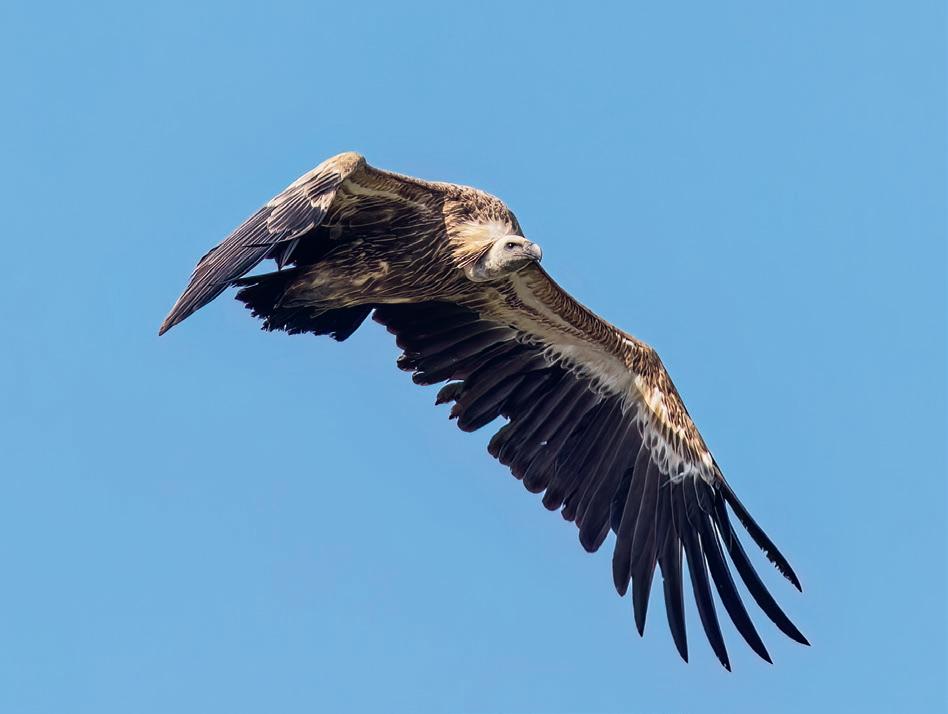
On the other side of the main road, the dirt track leads down to the Arda river. Look for Grecian Copper and Lattice Brown in the open patches between the trees. Balkan Lizard Orchids are frequent in this area and flower in June and July. Another typical wildflower is a climbing bush with white inflorescences – Cionura erecta. It is a species of the eastern Mediterranean growing on cliffs and, surprisingly, sandy coasts.
Continue by car in the direction of Borislavtsi. After another km you find a picnic table on the right side of the road where you can park.
4This is a good viewpoint, squeezed between the cliffs and the river. Check the cliffs where the Griffon Vultures breed. Birds of prey here frequently include Egyptian Vulture, Peregrine and Golden and Booted Eagles. Other birds to look for are Black Stork, Chukar (rare), Black-eared
Wheatear, Blue Rock Thrush, Western Rock Nuthatch, Rock Bunting, Alpine Swift and Crag Martin. On the other side, you have a good view over the river. Apart from the splendid scenery you might be lucky to spot an Otter in dusk or dawn.

Continue and take the first tarmac road to the right, which brings you down to the Arda.
5Leave your car at the end of the paved road (beyond it gets sandy and you may get stuck!) and continue on foot. Keep an eye out for fishing Black Stork on the pebble banks, and for Little Ringed Plover, which breeds here. Banded Demoiselles and Common Clubtail are frequent dragonflies in springtime. An early morning visit, in combination with a healthy dose of luck, may produce an encounter with the highly elusive Sand Boa, a European Glass Lizard, an Otter or a Jackal, all of which are seen here on a regular basis. Don’t forget to check the cliffs and the sky, for similar birds may appear here as on the previous site. Retrace your steps to the main road and turn right. After about 5 km you see a wooden gazebo on your left. Park here.
6The reservoir in the valley is part of the Arda River, which is dammed close to Ivaylovgrad. In the area a pair of White-tailed Eagle nests – one of the rarest breeding raptors of the region. They can sometimes be seen hunting over the area although your chances are better of spotting a Black Kite, another raptor that is not common in the region. Explore the Christ’s-thorn scrubland behind the gazebo which is a good site for Olivetree, Barred and Eastern Subalpine Warblers. Among the butterflies, Little Tiger Blue and Sandy Grizzled Skipper often rest on stones in the grassland.
7 Continue to the village of Borislavtsi and be careful as the road is in bad condition. Drive through the village (Spanish Sparrows breed in the storks’ nests) and stop at the first bridge. Scan the marshy grasslands that fringe the northern reservoir for Squacco Heron, Little Egret, Little Grebe and Cormorant. Barred Warbler may be present in the nearby bushes.
Continue over the dam and park on the left just before the next bridge. A 1.5 km walk along the stream leads you to a small lake.
8The fields on the left have Black-headed Bunting and Black-headed Wagtail. On your right, you overlook the bushy vegetation lining the stream. This is a good place for smaller songbirds and woodpeckers (Green and Syrian). The small lake at the end of the trail is fringed by marshland and reed beds. This makes this site an excellent one for Marsh Harrier, Kingfisher, Great Reed Warbler and Moorhen. Explore the grassy terrain near the lake for Pink Butterfly and Lady Orchids. Silver-studded Blue and Marsh Fritillary are so common in season that they cannot be overlooked.
Return the way you came.

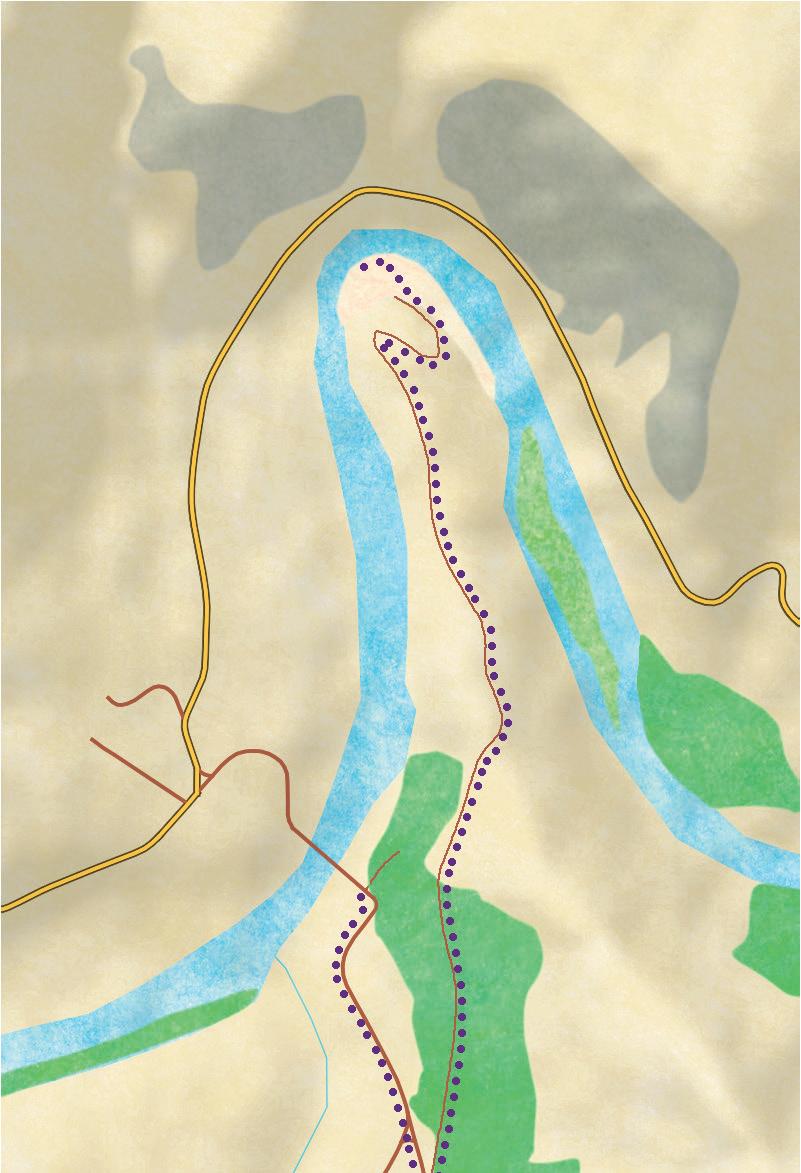
The banks of the Arda River, with their butterflies and dragonflies. Breathtaking views of the Kovan Kaya cliffs with its many vultures and other rock-dwelling birds.
Habitats: Christ’s-thorn scrub, rocks and cliffs, river banks
Selected species: Griffon Vulture, Black Stork, Blue Rock Thrush, Western Rock Nuthatch (rare), Grecian Copper, Small Bath White, Little Tiger Blue, Common Clubtail, Banded Demoiselle
The horseshoe river bend in the Arda river near Madzharovo is the hallmark image of the Eastern Rhodopes. It also graces the cover of this guidebook. Rather than looking over the bend, as you do on route 1, this route explores the pebble bank on the river, with the dramatic cliffs of Kovan Kaya forming the theatrical backdrop of this short walk.
Starting point Vulture centre (GPS: 41.643198, 25.871804; see point 1 of route 1).





Walk (or drive) along the road in the direction of Madzharovo, but instead of branching off to the right to the town, go straight on towards Senoklas. After 150 metres, go left and make a U-turn on a rough track (If you are still in a car, this is where you park).
1This fi rst section leads through dry, rocky scrubland made up of Christ’s-thorn bushes, or Paliurus spina-christi, so named as allegedly, the crown of thorns that Christ wore
1
Right from the very start, the route is beautiful. The steep slope on your right faces north and is covered with a tall, mature forest of Spruce, Fir, Beech, Sycamore, Hop Hornbeam and other trees. On the other side, it is mostly Austrian Pine that cover the slope. Closer to the river, willows, alders and poplars are common.
On sunny summer mornings, check the track and the verges of the vegetation for butterflies. Both White and Poplar Admirals can be found here in good numbers. The tall vegetation in the roadside, with Butterbur, Elecampane and Sticky Sage, indicate a nutrient-rich soil. Among these, there are some attractive wildflowers such as Fragrant and Eastern Spotted Orchid, Martagon Lily and the Balkan endemic Green-flowered Foxglove. In the river, Grey Wagtail is common and Dipper passes by from time to time.
2
As you climb you’ll see that the broad-leaved (deciduous) trees gradually disappear and the coniferous forest takes over. From the road the difference between spruce (cones hanging down from the branches) and fir (cones standing up from the branches) is very visible.
This is the habitat of Three-toed Woodpecker and Hazel Grouse. Both species occur here, although you’d be lucky to find either of them. Meanwhile, more interesting wildflowers present themselves – Red and Narrow-leaved Helleborines grow by the wayside, while Haberlea and the purple-flowered Saxifraga sempervivum grows on the cliffs.
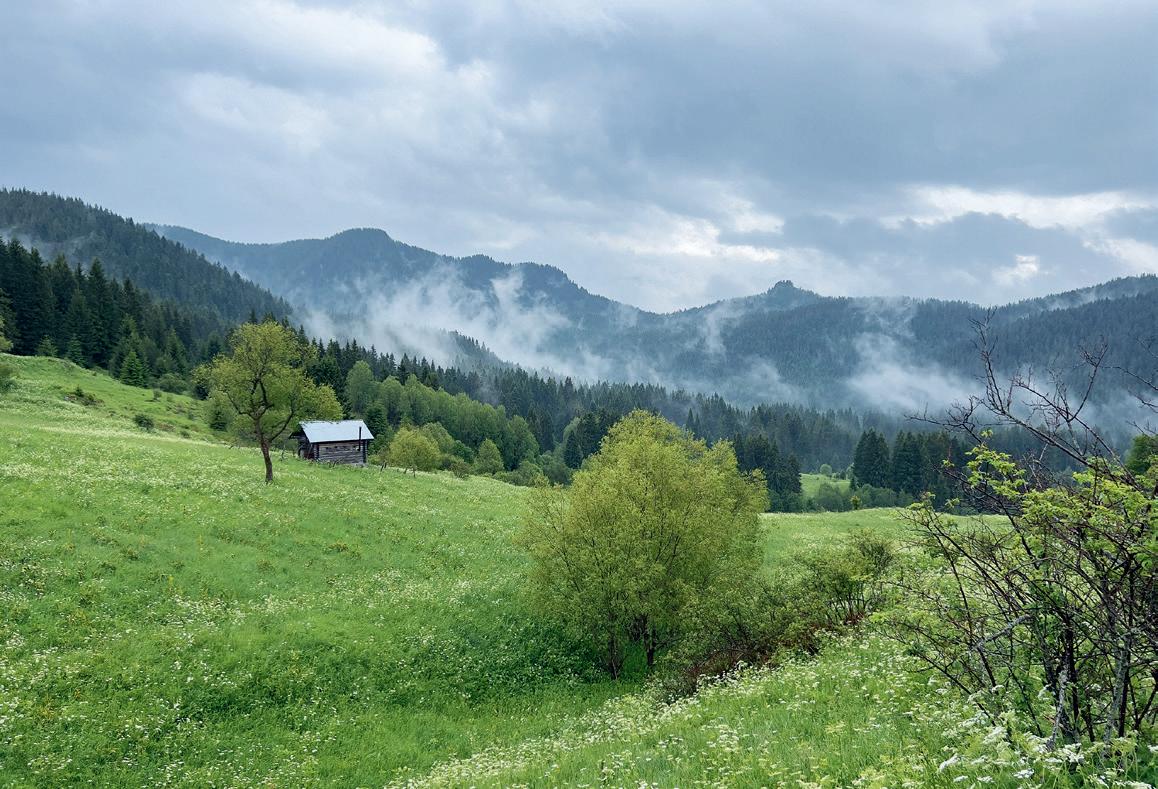
The track crosses the river. Here you may choose to follow the very steep but short trail straight up the mountain to Chairski, but we advise to keep following the track, which is not only much easier, but also more attractive (albeit longer).
3The track winds up the slope into an increasingly dense and mossy spruce forest. If you are here in July, scan the forest floor carefully for the enigmatic Ghost Orchid, which grows here in annually varying numbers. In good years, there can be hundreds. Other plants can be added to the list – Green-flowered Wintergreen, Herb-paris, Rhodopean Toothwort, Yellow Bird’s-nest, Bird’s-nest Orchid. The latter three are, just like the Ghost Orchid, parasitic plants. In these shady conditions, getting enough nutrients is a challenge. Rather than producing it through photosynthesis, ‘stealing’ nutrients by tapping into tree roots or fungi is an effective survival strategy.
In the roadside where there is more light, look for the yellow-flowered flax Linum capitatum, Willow Gentian and Fly Orchid. After a wooden shed, a track branches off to the left, which leads to the hamlet and the lakes (signposted Chairski Ezera). Before taking it, walk a little bit further and just before a glade, turn left on a path into the forest.
The larger part of the route follows a gentle track up through the gorge (left).

In early summer, look for Poplar Admiral that frequently rests on the path (top).

In July, the mossy old-growth spruce forests of points 3 and 4 (bottom) harbour a large (but annually fluctuating) population of Ghost Orchid (top).

route 19: walk to the chairski lakes
4
This trail is maybe only 100 metres long but brings you into an oldgrowth coniferous forest. It is not completely free of human influence but gives you a good feel of the interior of such very old forests.

Return and follow the track to Chairski Ezera.
5 You cross the river and proceed through old forest until you arrive at the first of the Chairski Lakes. Note that they are mires rather than lakes, with a special vegetation, with Marsh Cinquefoil, the orangeflowered avens Geum rhodopaeum, Bogbean, Heart-flowered Marsh-orchid and others. Look carefully from the edge of the marsh.
6
Just beyond the lake you arrive at the hut where you can get refreshments in the summer months. In the meadows around the hut, there are more attractive plants and butterflies. We found Bug Orchid here and when you walk the track behind the hut to the right, there are some small marshes with Balkan Copper and Marsh Fritillary. Under the roof of the shed in front of the hut Crag Martin, Common Swift, Barn and Red-rumped Swallow breed.
Return by the way you came.

Beautiful walk along a river with many waterfalls. Splendid old-growth spruce forest. Perhaps the best place to find the elusive Three-toed Woodpecker.
Habitats: Subalpine spruce forest, mountain meadows mountain streams


Selected species: Green-flowered Wintergreen, Rhodopean Lily, Three-toed Woodpecker, Black Woodpecker, Crested Tit, Fire Salamander




The waterfall valley in the Soskovtcheto nature reserve is a rather famous destination near the town of Smolyan. It lies a bit out of the way from the other locations in this book but is very much worth the effort to visit. This is the only west Rhodope walking route in this book that is not on limestone, but on hard, water-resistant volcanic bedrock. Rainwater doesn’t sink away but flows down a steep valley in countless rapids and waterfalls. The gorge itself is so steep that commercial forestry is impossible. Massive spruces grow on the slopes and moss-covered trunks lie haphazardly over the river – the classic sight of an old-growth forest. Although the terrain is wild, the trail is reasonably easy, thanks to small fl ights of steps and no less than fi fteen bridges that swing from one side of the river to


Three airports service the region: Sofia, Burgas and Plovdiv. Most people will arrive at Sofia International Airport because it is served by flights from most European airports. From Sofia, it is about 2.5 hours by car to Haskovo, the gateway to the Eastern Rhodopes. It is a similar distance from Burgas airport to Haskovo. Burgas lies on the Black Sea coast which happens to be an excellent wildlife destination that is often combined with a visit to the Rhodopes, making Burgas airport the better choice. The downside is that there are few flights in spring, as the Black Sea coast is above all a summer destination. Most flights to Burgas are from Poland, the Baltic States, UK, Ireland, Germany, the Scandinavian countries and Belgium. Plovdiv has the great advantage of actually being in the region. However, there are even fewer flights to Plovdiv – most of them are from London, Dublin and from a few places in Germany.
By far the easiest way to travel in the region is by car. The traffic is usually light and driving is generally safe. The roads have improved tremendously in the last decade and are mostly in good or even excellent condition. However, some driving along poor quality roads or tracks to reach all of the sites we mention is unavoidable so take care and always turn back if concerned.
There are plenty of car rental companies at the airports and all major towns. Also make sure you have a ‘vignette’ (road tax) for your time in Bulgaria. If you rent your car in Bulgaria, the vignette is arranged by the rental company. If you are travelling with your own car, buy a vignette at the border station, one of the large petrol stations on the motorway or at the post office.
To get to the areas covered in this book, the train is not of much use. There is only one line, which goes from Sofia to Istanbul and runs all along the Maritsa valley, via Plovdiv (with a branch to Asenovgrad) and further east to Simeonovgrad, Dimitrovgrad and, just before the border, Svilengrad.
Bogdan Boev is a professional wildlife photographer who works both in the Rhodope region and in his other homeland, Scotland: www.bogdanboev.com, E: info@bogdanboev.com
Bogdan has several hides in the Thracian Plain and the Eastern Rhodopes, not only for the big raptors, but also for the smaller birds like Rollers. Several of the bird photos included in this book are Bogdan’s and were taken from these hides.
Tsvetomira Yotsova is a guide based in the beautiful village of Gorno Pole (near Madzharovo) and also has a B&B. Tsvetomira is an experienced, English-speaking ornithologist and wildlife guide – see Happy Rhodopes on facebook, or mail tsvetomira.yotsova@gmail.com
The numbers within brackets (…) refer to the routes from page 133 onwards. WR refers to the Western Rhodopes and ER to the Eastern. TP refers to the Thracian Plain.
Partridges Chukar is an uncommon but widespread resident of the ER (3, 6, 11), while its European counterpart the Rock Partridge occurs in open areas in the WR (16, 18). Ring-necked Pheasant, Quail and Grey Partridge occur in agricultural terrain in the lowlands (e.g. 23 and sites B and C on page 248-249).
Grouse Both Hazel Grouse and Capercaillie breed in the higher parts of the WR (16 (only Capercaillie), 17, 19). The best way to find them is on a guided trip (see page 227 and 262).
Swans, Geese and Ducks The Thracian Plain is of great importance for wintering ducks, but only few stay to breed. Sites B-E on pages 248-251 and the Ivaylovgrad reservoir (1) have wintering Wigeon, Gadwall, Teal, Pintail, Shoveler, Red-crested Pochard (rare), Pochard, Tufted Duck, Goldeneye (rare) and Smew (rare) in winter. White-headed Duck regularly winters near Galobovo and Ovchi Kladanets (site E on page 251). Mute Swan, Mallard, Ferruginous Duck, Common Pochard and Garganey are scarce breeding birds of the Trud Fishponds (site B on page 248). The reservoirs in the ER are breeding sites of Ruddy Shelduck and Goosander (6, 10). Among the wintering Geese (sites A-E on page 248-251), White-fronted is most common, Greylag less so and in larger flocks, there are usually the odd specimen of Red-breasted Geese (which is a common winter bird near Burgas).
Grebes Great Crested and Little Grebes are fairly common breeding birds of wellvegetated lakes (e.g. B on page 248). Red-necked and Black-necked Grebes are rare winter visitors, although Red-necked recently bred as well.
Pelicans, Flamingos and Ibises Both Dalmatian and White Pelican roost in increasing numbers on reservoirs in the TP (site E on page 251) and Studen Kladanets reservoir (5). Dalmatian is most common and present for much of the year, Great
White is there during migration. Greater Flamingo sometimes roost at Studen Kladanets (5), mostly in summer and autumn. Glossy Ibis is scarce but increasing. At time of writing, a small colony just established at the Trud Fishponds (site B on page 248) and birds roosted at the Kardzhali heronry (5).
Cormorants Great Cormorant is a common resident at all larger waterbodies. Pygmy Cormorant occurs very locally – there is a colony in Kardzhali (5) and a large winter roost near Plovdiv.
Bitterns, Herons and Egrets Grey Heron is present in all larger water bodies. Little Egret is fairly widespread. There is a breeding colony, together with Night Heron and a few Squacco Heron in Kardzhali (5). Sites A, B and C are good for Night Heron, Squacco Heron, Little Bittern and Great White Egret, the latter being above all a winter visitor. Site D on page 250 is excellent for Little Bitterns. Great Bittern is a rare breeding bird of the TP. The same goes for Cattle Egret, whose first breeding attempt was in 2020 (and is likely to become more widespread soon). Purple Heron is seen on migration and may breed as well.
Storks White Storks are common breeding birds of towns and villages throughout the area. Black Stork is a common breeding bird of the ER (e.g. 1, 2, 5, 6, 8, 11 and site A on page 181). Just before and after the breeding season, Black storks congregate in the Maritsa valley (22, sites A-E on pages 248-251).
Vultures The ER and Sakar are among the best areas to watch raptors in Europe. There are Griffon Vulture colonies at 1 and 5 and these birds can be seen all over the Madzharovo-Kardzheli area. Egyptian Vulture breeds throughout the same region. Black Vultures sometimes wander in from their breeding sites just across the Greek border. In 2022 a reintroduction program started on an undisclosed location in the Madzharovo region, so it is expected that this bird will become more numerous here in the coming years. The best places to see lots of vultures (including Egyptians) are route 1, 8 (the vulture feeding station) and the hunting reserve (site A on page 181). For photography from a hide, see page 262.
Eagles Golden Eagle is widespread in both the ER and WR (best 1, 6, 8 9, 10, 15, 16 and 17). Most of Bulgaria’s Eastern Imperial Eagles breed in Sakar, where you stand a good chance of seeing them (23, 24). Lesser Spotted Eagle is another bird of Sakar, but it roams a bit more widely (13, 23, 24). White-tailed Eagle breeds on the larger reservoirs (1, 5, site A on page 181). Booted and Short-tailed Eagle are widespread though not very numerous in the TP, Sakar and ER (e.g. 1, 5, 6, 11, 21, 22, 23, 24).
Other birds of Prey Marsh Harriers are fairly common in wetlands (1, 22, sites A-E on pages 248-251). Hen Harrier is a widespread winter visitor of the TP, Sakar and ER. Montagu’s Harrier is a scarce breeding bird of the TP (21, 23) and Pallid Harrier a scarce migrant. Black Kite is fairly common, especially along the Maritsa and Arda rivers (best 1, 5, 8, 22, 23, site A on page 181). Levant Sparrowhawk is another river bird, best seen on 22, but also 8. Goshawk, Sparrowhawk and Honey Buzzard are widespread in the forested parts of the mountains. Common Buzzard is
widespread throughout, while Long-legged Buzzard is largely a steppe and lowland bird (best 21, 23, 24). Bonelli’s Eagle no longer breeds, but occasionally wanders into the Rhodopes from the south. Osprey passes through in spring and autumn and is seen mostly on the reservoirs of the Arda, the Maritsa River and Thracian Plain. Falcons Kestrel is widespread. Lesser Kestrel breeds at Levka (23). Hobby is widespread along rivers. Eleonora’s Falcon hunts over the Rhodopes in late spring and early summer (best 8). Red-footed Falcon passes through in low numbers in April and May in the TP, but they haven’t bred in the area in the past years. Of the big falcons, Peregrine is most common. Saker is subject of a reintroduction program just outside our area but may turn up in the TP and Sakar. Lanner is a rare, possibly extinct, breeding bird of the ER (best chance on 12).
Crakes, Rails and allies Low numbers of Coots and Moorhen are present in the lowland marshes (1, 22, sites A-E on pages 248-251). Rails are uncommon or rare at the same sites.
Waders Black-winged Stilt breeds in some of the TP marshes (best A-C on pages 248-249). Collared Pratincole breeds in scattered colonies essentially in the same region. We found large numbers in the fields around the Trud Fishponds (B on page 248). Stone Curlew is a scarce breeding bird of the steppes and lowlands (21, 23, 24) but also of bare reservoir shores (e.g. site A on page 181). Lapwings are fairly common breeding birds and common in winter and on passage (best A on page 248). Oystercatcher is a surprising breeding bird of islands in the Maritsa (22). Little Ringed Plover (common), Green and Common Sandpiper (both scarce) breed along the major rivers.
Gulls and terns Yellow-legged is the ‘default’ gull on all major water bodies. Black-headed is scarce in the lowlands, where Little Gull is sometimes found on passage. Whiskered and possibly Black Tern breed locally (best C on page 249); Black and White-winged Terns migrate through the same area in good numbers. Common Tern breeds on the river and the larger reservoirs (1, 5, 22).
Doves and Pigeons Turtle Dove is a common species of open woodlands and agricultural land. Ring-necked Dove is common in towns and villages. Wood Pigeon is widespread in the forests and recently started to breed in the city parks, while Stock Dove breeds in fairly low numbers in the WR.
Cuckoos Cuckoo occurs throughout the wooded parts of the area. Great Spotted Cuckoos are rare and erratic. It is most frequently seen at Besaparski (21).
Owls The most common lowland owls are Barn, Scops and Little Owls (the latter is often seen sitting on a pole or barn roof). Scops Owl is astonishingly common in Madzharovo and often seen around the building blocks at dusk. Tawny and Longeared Owls are the most common owls of woodlands, joined by Eagle Owl in large woodlands and rock ledges. Both Tengmalm’s and Pygmy Owls are rather scarce but widespread in the coniferous forests of the WR.
Swifts and Nightjar Both Common and Pallid Swifts are present throughout the area (with Pallid more patchily in the WR) and form a nice puzzle for birdwatchers. There are large Alpine Swift colonies in the Rhodopes (1, 5, 18, site A on page 222) and the bird itself can be seen everywhere in the mountains. Nightjar is common in the karstic parts of the WR and all over the ER and Sakar.
Hoopoe, Kingfisher, Bee-eater and Roller Hoopoes are common throughout the TP and the warmer parts of the ER. Kingfisher (1, 5, 8, 22, 23, site B, D and E on page 248-251), Bee-eater (1, 8, 21, 23) and Roller (8, 22, 23) are most common in the river valleys of the Arda and Maritsa.
Woodpeckers Although almost all European woodpeckers breed in the region, many are hard to find. Great Spotted is, as in most places, the most numerous woodpecker. Syrian Woodpecker largely replaces it in the TP (21-24; sites A-E on page 248-251). Green Woodpecker is common along rivers and larger forests. Grey-headed is locally common in Beech forest and mature oak stands (6, 9, 12, 16). Black Woodpecker is widespread, occurring in all older forests. Middle-spotted Woodpecker is widespread in mature oak stands (e.g. 3, 17, 22). Lesser Spotted prefers the same sites, but needs softer wood, which it finds mostly near rivers. Wryneck is not as frequentas in the past but can still be found in and around bushy areas near villages, particularly in the Rhodopes. White-backed Woodpecker is rather rare, occurring in mature Beech forest (12). Three-toed Woodpecker is restricted to old(growth) spruce forests (17-20).
Larks Woodlark is common in half-open woodlands and occurs commonly from Sakar to the karstic areas of the WR. Skylark is more local, in meadow landscapes in the same region. Crested Lark is common along roadsides, ploughed land and dry grasslands from the lowlands up to the dry slopes of the ER. Calandra Lark and Short-toed Lark are steppe birds that occur rather locally, but sometimes in good numbers (e.g. 13, 21, 23, 24).
Martins and Swallows House Martin, Barn Swallow and Red-rumped Swallow are common throughout the region. Sand Martin is locally common in the lowlands (21, 22). Crag Martin is common in rocky places in the Rhodopes.
Pipits and Wagtails Tawny Pipit is a local breeding bird of dry agricultural areas and steppe (21, 23, 24). Tree Pipit is a common breeding bird of the half-open woodlands in the WR (15-18). Water Pipit may breed on the highest slopes of the WR, but is widespread in winter in the TP. White and Black-headed Wagtails are common, the latter mostly in agricultural land in the lowlands. Grey-headed Wagtail is frequent along the larger streams of the WR and locally in the ER (6, 15, 19, 20).
Wren, Robin, Dipper and Accentors Wren occurs mostly in the mountains in wellvegetated ravines and mountain forests. Robin is a more widespread forest bird. Dunnock and Alpine Accentor breed in the highest parts of the WR, but are fairly widespread winter visitors to the WR and ER. Dipper is fairly common along the streams of the WR (6, 15, 19, 20).
Redstarts, nightingales, chats and wheatears Black Redstart is locally common in karst landscapes and on cliffs, plus in villages in the WR. Redstart is surprisingly rare. Nightingale is common in any damp, dense vegetation. Stonechat is widespread but rather uncommon in the lowlands, while Whinchat breeds in mountain meadows (18, 19) and during migration (in May) can be seen throughout the region. Northern Wheatear has become rather scarce and is mainly found in open, rocky areas. Isabelline Wheatear is locally common in deep-soiled steppe (5, 13, 21, 22, 23). Eastern Black-eared Wheatear breeds on cliffs and in quarries (1, 5, 11, 21, 24).
Thrushes Rock Thrush and Blue Rock Thrush are both uncommon breeding birds of cliffs, with the former seeking out the cooler, higher sites (1, 5, 6, 8, 16), and the latter present on the hotter part of the mountains (1, 3, 5, 6, 8, 21), but there is a considerable overlap. Song and Mistle Thrush breed in forests in the ER and WR and Blackbird is common throughout. Ring Ouzel breeds in open Subalpine forests (17, 18, 19). In winter, Fieldfare, Song Thrush, Mistle Thrush and Redwing occur in the lowlands.
Warblers There is a large diversity of warblers of the genus Sylvia/Curruca present in the region. The familiar Blackcap, Whitethroat and Lesser Whitethroat are perhaps most common. The latter usually breed in scrubland, together with the more localised Barred Warbler, the latter always in the vicinity of Red-backed Shrikes (1, 8, 9, 23, 24). Eastern Orphean Warbler is associated with scattered bushes and trees in the ER and Sakar (e.g. 1, 6, 7, 9, 10, 23 and 24). Eastern Subalpine and Sardinian Warblers are much less numerous and prefer the denser scrublands near hot, rocky areas in the eastern ER (1, 2, 4; site C on page 194).
Of the three Hippolais/Iduna warblers present in the region, Eastern Olivaceous Warbler is the most common, occurring in any shrubby, or wooded terrain in lowlands, particularly near water courses and, interestingly, in city parks (e.g. 1, 2, 6, 8, 11, 14, 22, 23). Olive-tree Warbler is local and rather rare in the ER, but locally fairly common in Sakar (11, 23). Icterine Warbler is sometimes found on passage. Of the marshland warblers, Reed and Great Reed Warblers are both numerous in reedy terrain (5, 22, sites A-E on pages 248-251). Sedge Warbler seen occasionally during passage. Sightings of Moustached and Savi’s Warblers are both exceptional. Cetti’s Warbler is a recent addition to the birdlife of the region, now breeding in lowland river habitat (22, 23). Eastern Bonelli’s Warbler is pretty much restricted to the ER and Sakar, where it is widespread but occurs on low numbers in the denser oak stands (e.g. 3, 4, 9, 14, 23, 24). Wood Warbler breeds very locally in Beech forests (12).
Crests Both Firecrest and Goldcrest are fairly numerous in the coniferous forests in the WR, with Goldcrest preferring the pines and Firecrest the spruces (16-20).
Flycatchers Flycatchers are surprisingly rare in the area. Pied, Semi-collared and Collared Flycatchers all pass through on migration, but in low numbers. Semi-collared Flycatcher breeds in the ER and also in the WR in old beech and oak stands
(9, 12) but in very low numbers and in hard-to-access places. Spotted Flycatcher breeds in the ER and edges of the WR (e.g. 15) but also in low numbers.
Tits and allies Long-tailed, Blue and Great Tits are widespread. Marsh, Willow, Coal, and Crested Tits occur in the coniferous forests of the WR (16-20). Sombre Tit is widespread in the ER and Sakar in mixed oak woods, orchards and scrubland. It can turn up anywhere in the ER – we found them to be numerous in the hunting reserve (site A on page 248). Penduline Tit breeds locally along the Maritsa (22).
Nuthatches, Treecreepers and Wallcreeper Nuthatch is frequent in mature oak and beech forest. Western Rock Nuthatch is a local bird of dry rocky terrain (best 11, but also 1, 5 and is possible elsewhere, including in the WR). Eurasian Treecreeper is widespread in the coniferous forests of the WR, while Short-toed Treecreeper is rather uncommon in oak woods in the ER. Wallcreeper is a scarce breeding bird of the WR. For many years now, the Trigrad Gorge (site A on page 222) has been one of the easiest places on the continent to get good views of this bird.
Shrikes Both Red-backed and Woodchat Shrikes are common throughout the area (the latter not in the WR). Lesser Grey Shrike is more restricted to steppes, agricultural land and river floodplains (1, 5, 8, 11, 13, 21, 22 and 23). Masked Shrike is the rarest of the shrikes, occurring in open woodland, with a preference, it seems, to rivers. It has been seen in many places, but is notoriously difficult. The best place (by far) to find it is route 22 and 23.
Crows and allies Magpie, Jay, Hooded Crow, Jackdaw and Raven are all common in suitable habitat. Nutcracker is frequent in mountain spruce forest (18, 19). Rook is a common winter visitor to the TP.
Starlings and Golden Oriole Common Starling is abundant. The nomadic Rosy Starling occurs in invasion years (once every 2-3 years) and can then reliably be seen in Besaparski (21). Golden Oriole is common throughout the lowlands and lower mountains (very numerous at 22).
Sparrows House and Spanish Sparrow is common throughout (often occurring together). Tree Sparrow locally common in the lowlands. Rock Sparrow is a rare breeding bird of quarries in the Besaparski hills (21).
Finches Chaffinch and Hawfinch are common breeding birds of the Rhodopes. Bullfinch breeds in the beech forests of the WR. Linnet, Goldfinch and Greenfinch occur throughout the lowlands, while Serin is found in rural parts of the WR. Siskin and Crossbill breed in the coniferous forests of the WR.
Buntings Corn and Black-headed Buntings are common in all agricultural plains (but the latter arrives late, in the beginning of May). Cirl and Ortolan Buntings are abundant in park-like landscapes, open woodland and scrubland of the ER (3, 4, 5, 6, 9, 10, 11). Rock Bunting is rather uncommon and found in rocky terrain of the WR and ER (1, 5, 6, 12, 15, 16, 17, 18). Reed Bunting is a rare breeding bird of large reedbeds, but quite common there in winter.
The Rhodope Mountains lie in Southern Bulgaria on the border with Greece and Turkey. This is the region where continental, temperate and Mediterranean wildlife meets. The Rhodope mountains are covered in extensive forests. There are high cliffs and thunderous rivers, but also extensive, steppe-like grasslands and dry, rocky slopes. The wildlife is amongst the richest in Europe. Large numbers of birds of prey patrol the skies, wolves and jackals hide in the woodlands and scores of butterflies and wildflowers grace the meadows. Remote and wild as this region may seem, it is actually very easy to visit. This guidebook tells you all about the Rhodopes and describes many routes and sites to explore these mountains and their flora and fauna.
• The guide that covers the wildfl owers, birds and all other wildlife
• Routes, where-to-watch-birds information and other observation tips

• Insightful information on landscape and ecology


“Everything you need to turn up in the right place and at the right time to find some of the best wildlife in Europe”


 Chris Packham – BBC Springwatch
Chris Packham – BBC Springwatch
WWW . CROSSBILLGUIDES . ORG - IF YOU WANT TO SEE MORE
BULGARIA Rhodopes GREECE